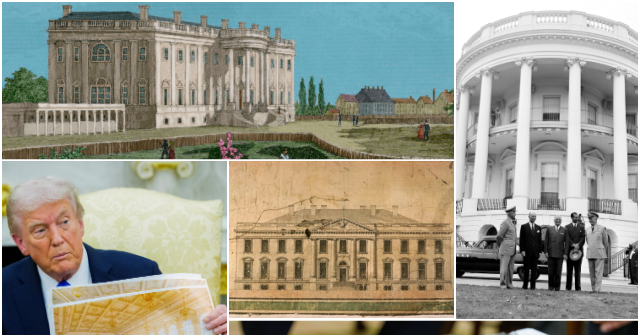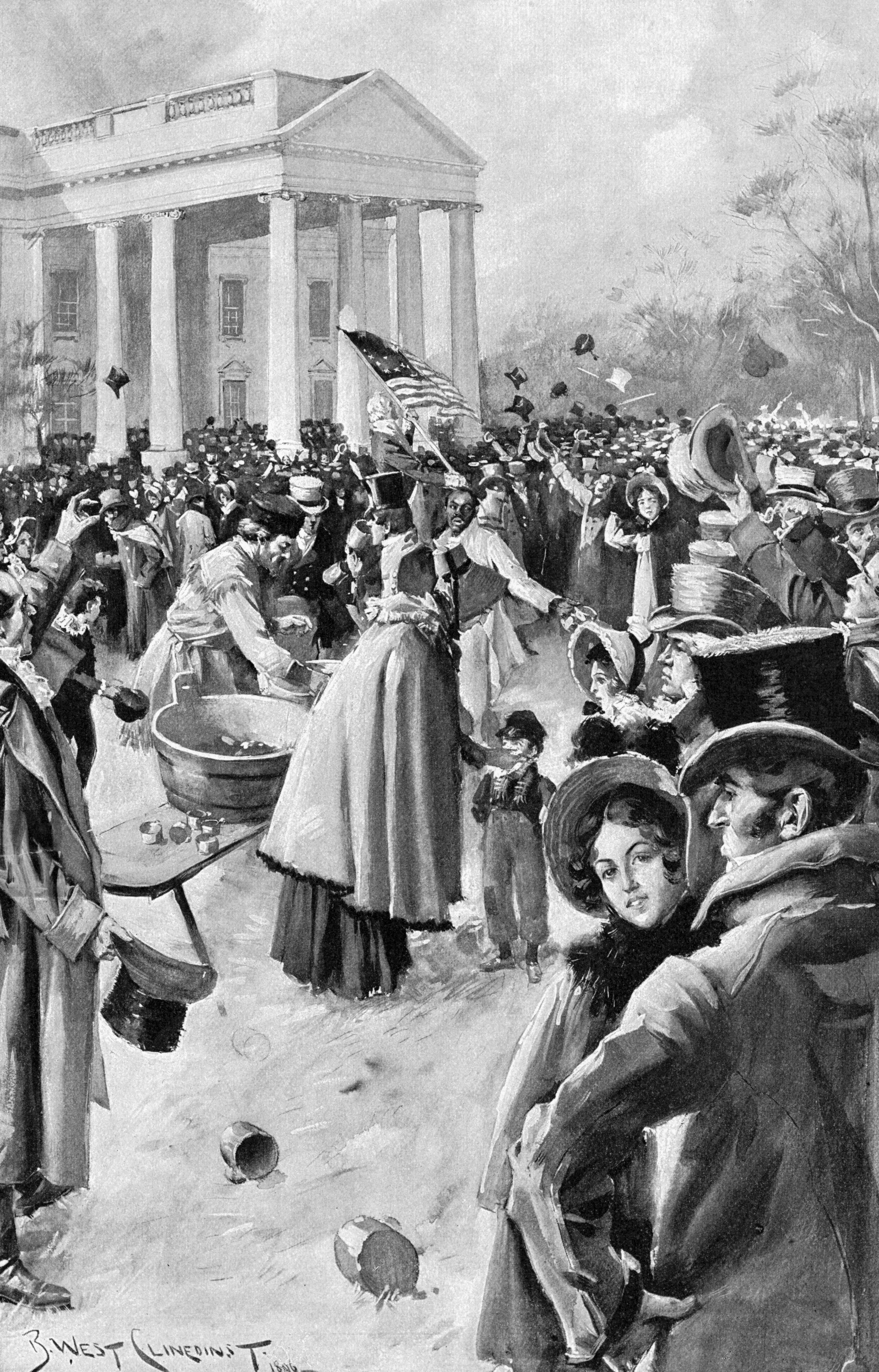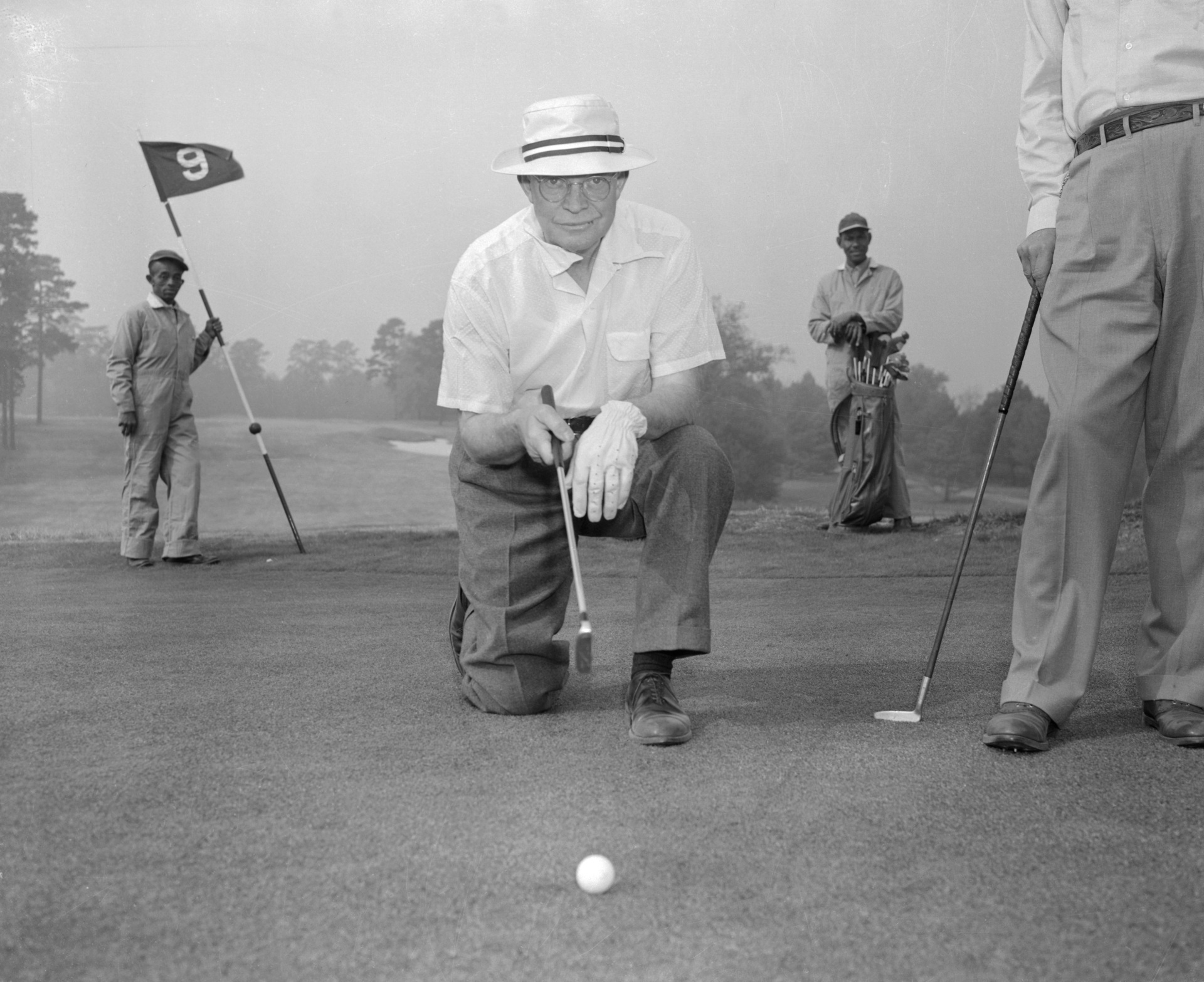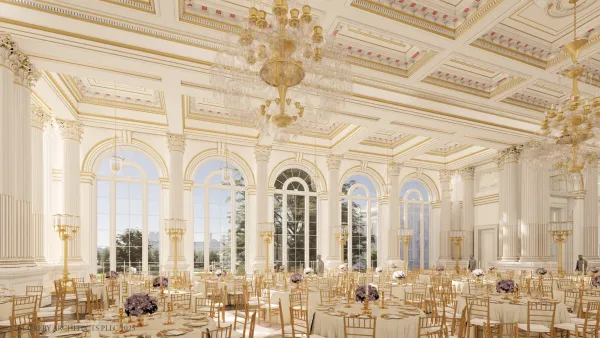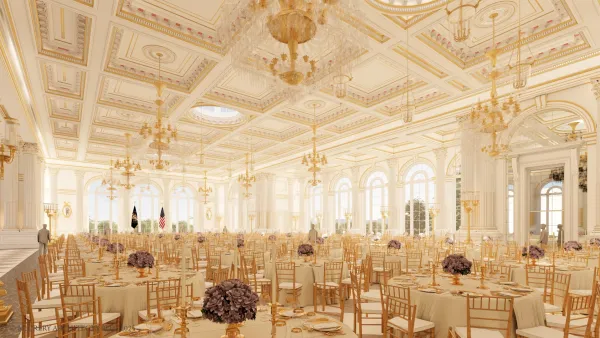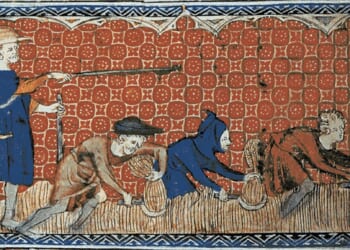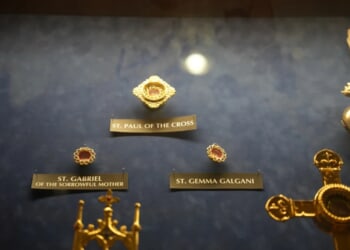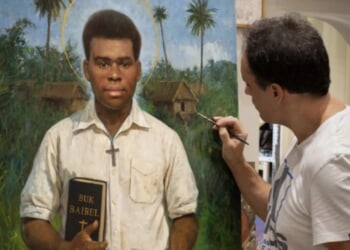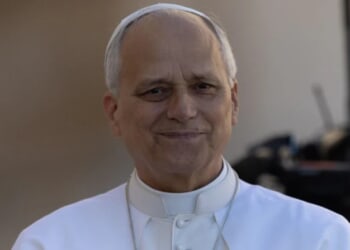On November 2, 1800, President John Adams penned a quick letter to his beloved wife, Abigail, to inform her that he had arrived in the new capital city and that their still unfinished residence—which he simply called “the President’s house”—was “habitable.” He ended with a hopeful prayer: “I pray Heaven to bestow the best of Blessings on this House and all that shall hereafter inhabit it. May none but honest and wise Men ever rule under this roof.”
His prayer turned out to be more aspirational than predictive. Although I’m certain the Almighty has bestowed His blessings on our nation, the inhabitants of that house have been a mixed bag of dishonest and foolish along with honest and wise.
And almost none of them lived under the same “roof” that Adams did. The structure that we now call the White House has been burned, trashed, demolished, dilapidated, gutted, and subjected to every kind of indignity—from poor taste to debauchery—for the past 225 years. The only thing connecting the current structure to the barely “habitable” building that Adams first entered is some of the sandstone exterior walls.
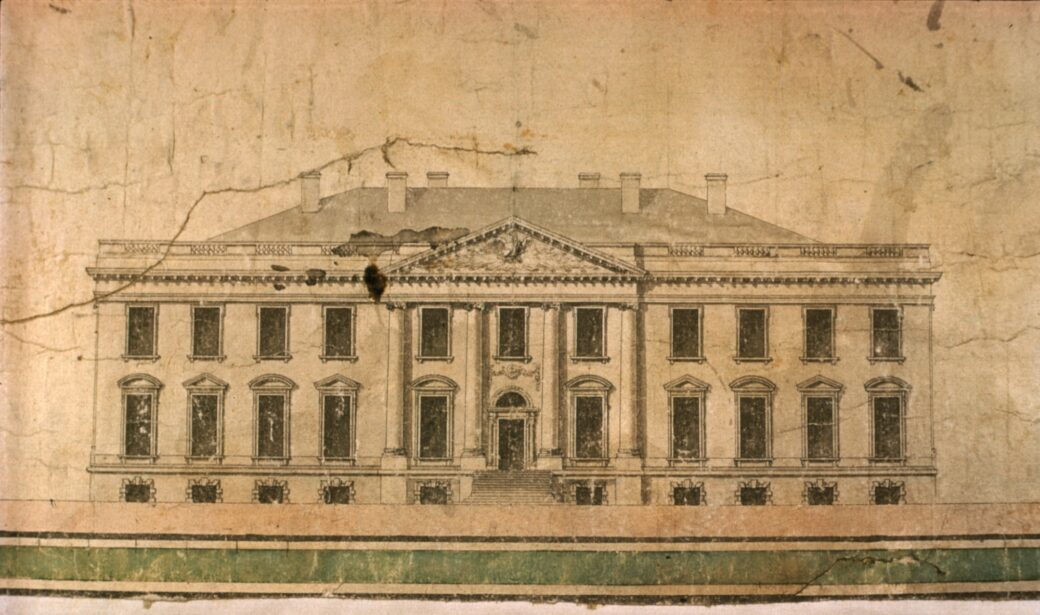
White House architect James Hoban’s 1793 drawing of the north side elevation of the White House. (Wikimedia Commons)
The White House has been a work in progress from the moment architect James Hoban won the design contest to build it. The current structure at 1600 Pennsylvania Avenue was mostly reconstructed 73 years ago by Harry Truman. (Nancy Pelosi and Chuck Schumer are older than the White House interior!)
Every White House renovation has been a source of controversy. And nearly all additions to the “People’s House”–including the ones that we now regard as iconic–were denounced at first by critics.
The current hysteria over President Donald Trump’s Big Beautiful Ballroom is the latest in a long history of Washington architectural naysaying that is as perennial as the Potomac cherry blossoms and as old as the White House itself.
There is nothing remotely “unprecedented” or “undemocratic” about Trump’s building project. It’s by far the most precedented thing he’s ever done in Washington. In fact, it would be truly unprecedented if a president who is world-famous for restoring historic buildings didn’t make changes to the White House. He is the most qualified person in the world to build a ballroom, and he’s doing it for the right reasons (to improve the property for everyone) and in the right way (without taxpayer money), all in keeping with the best traditions of his predecessors.
Any honest review of the historical record will show that the “People’s House” has endured far worse insults to its structural integrity and cultural dignity than anything Trump could or would do to it.
So, let’s review the history…
Thomas Jefferson’s Un-Democratic Colonnades
As noted, John Adams was the first occupant of the building that would be nicknamed “The White House” due to its whitewashed exterior, which was added to protect its porous sandstones from Maryland’s swampy weather. Adams didn’t live there long enough to do anything to the house, which, in those early years was barely “habitable,” let alone hospitable. His successor, Thomas Jefferson, was the first president to leave his mark on the structure.
As anyone who has visited Monticello can attest, Thomas Jefferson was a man of impeccable architectural taste. As a lover of the Palladian architectural style that was popular in 18th century Europe, Jefferson commissioned the architect Benjamin Henry Latrobe to add two Palladian-inspired colonnades to the east and west of the residence, creating covered walkways that connected the house to service “wings” that would later be built (and rebuilt).
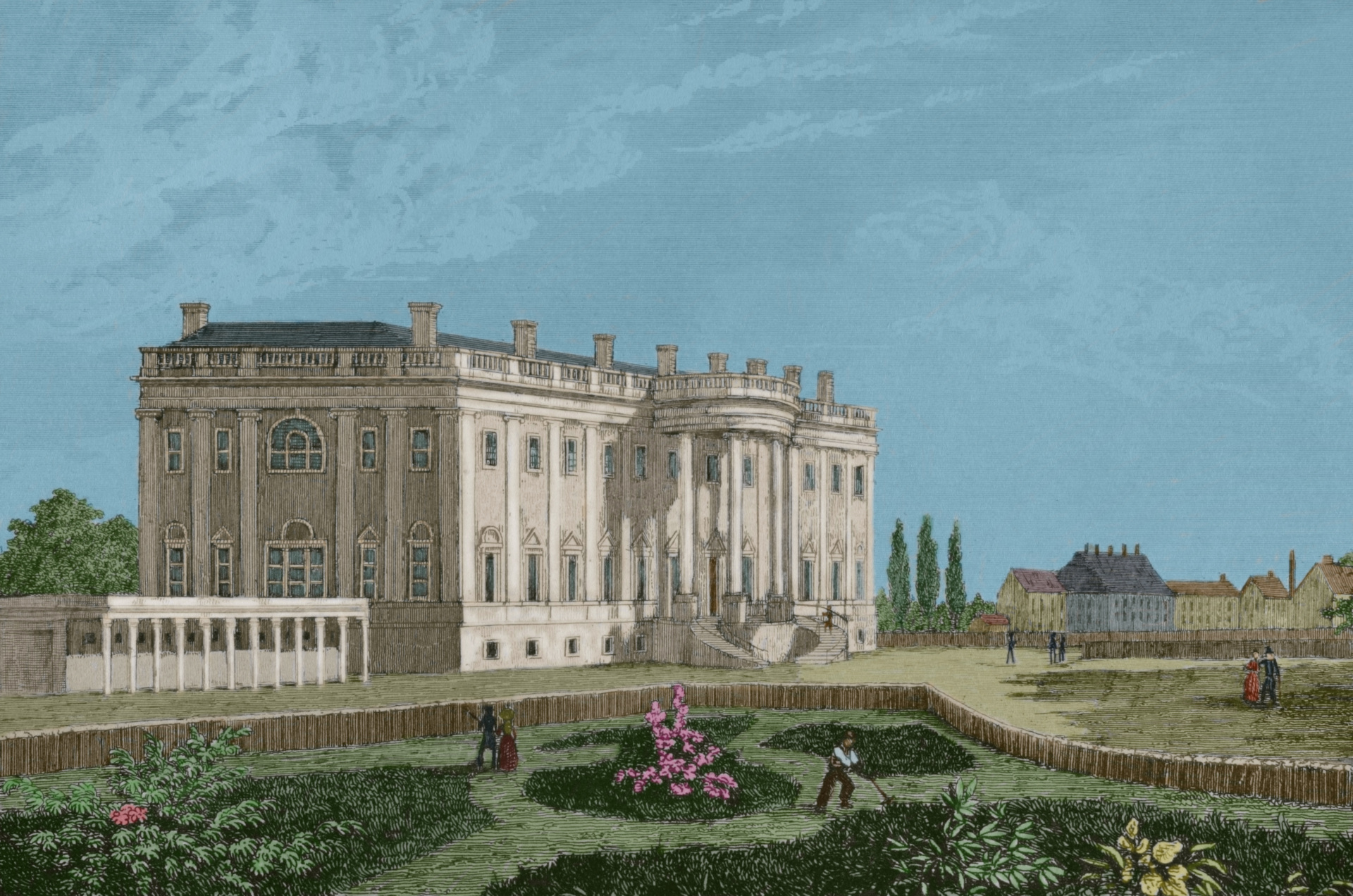
An 1837 illustration of the White House showing one of the Jefferson colonnades on the left. (PHAS/Universal Images Group via Getty Images)
Jefferson’s colonnades were immediately controversial and vociferously criticized in Congress and in the press for being too extravagant for the financially strapped young republic. Had Jefferson, the former ambassador to the Court of Louis XVI, spent too much time in the gilded halls of Versailles? Did he think he was some kind of king with these fancy colonnades? His critics claimed that such aristocratic frippery was at odds with American democracy.
Though Jefferson’s colonnades were removed in 1866 and rebuilt in 1902, their winged structure was foundational to the White Houses’ architectural layout. You could say that the White House’s winged footprint is an heirloom of Jeffersonian Democracy.
Burned by the Brits
Jefferson’s colonnades survived the fire that sent his successor, James Madison, fleeing an invading British army that torched the White House on August 24, 1814.
Before fleeing the burning building, First Lady Dolley Madison heroically saved the famous Gilbert Stuart portrait of George Washington to ensure that it didn’t fall into the hands of the great man’s enemies.
Eventually D.C. was saved by a thunder storm that doused the fires and sent the Red Coats back to their ships. But the White House was left a smoldering stone shell.
Practically the entire structure had to be rebuilt—the roof, the windows, the chimneys, the stairways, the whole interior—everything but some of the sandstone walls, Jefferson’s colonnades, and the exterior footprint of the residence.
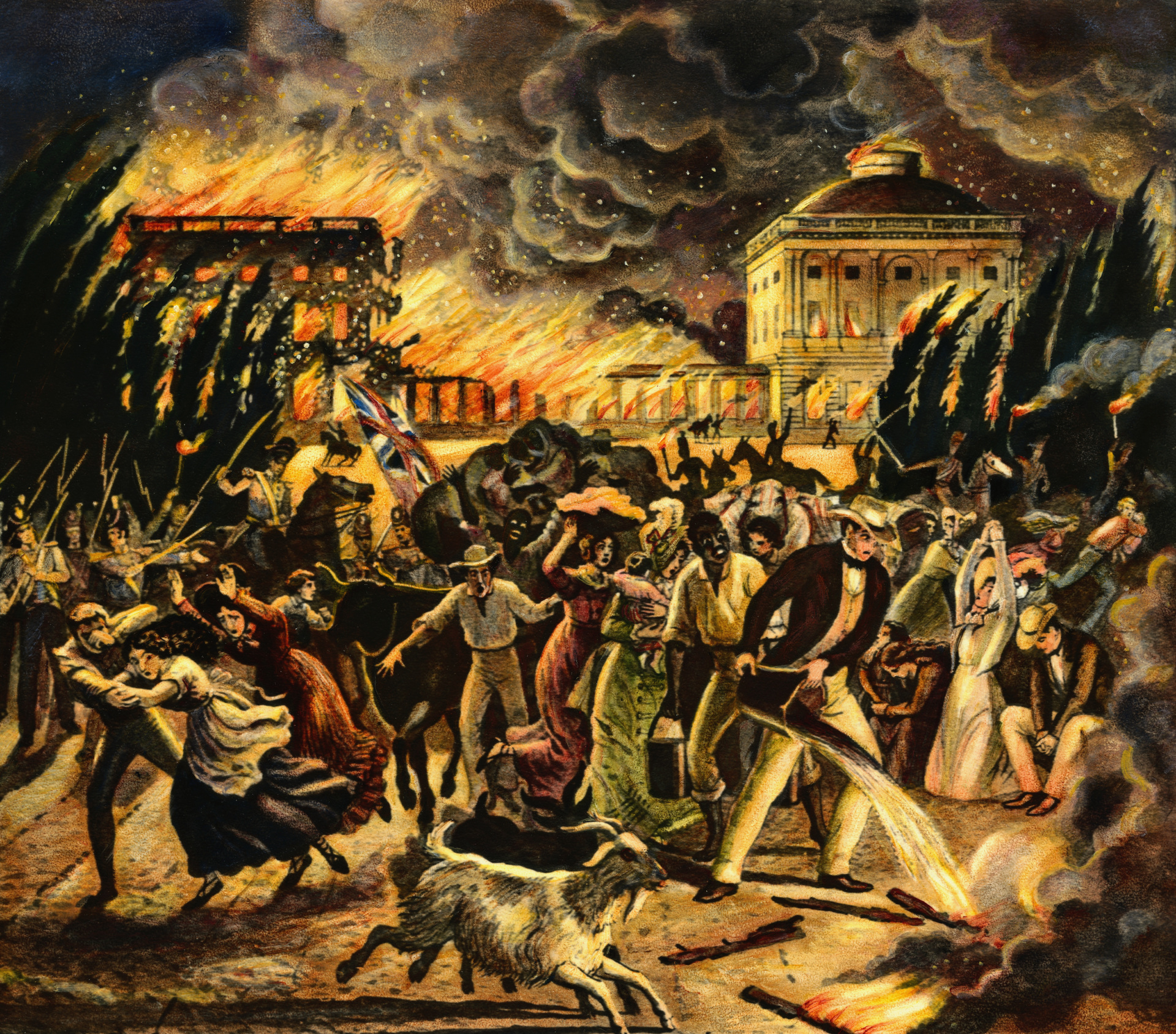
The burning of Washington, DC, by the British in 1814. The White House is seen in the background. (Getty Images)
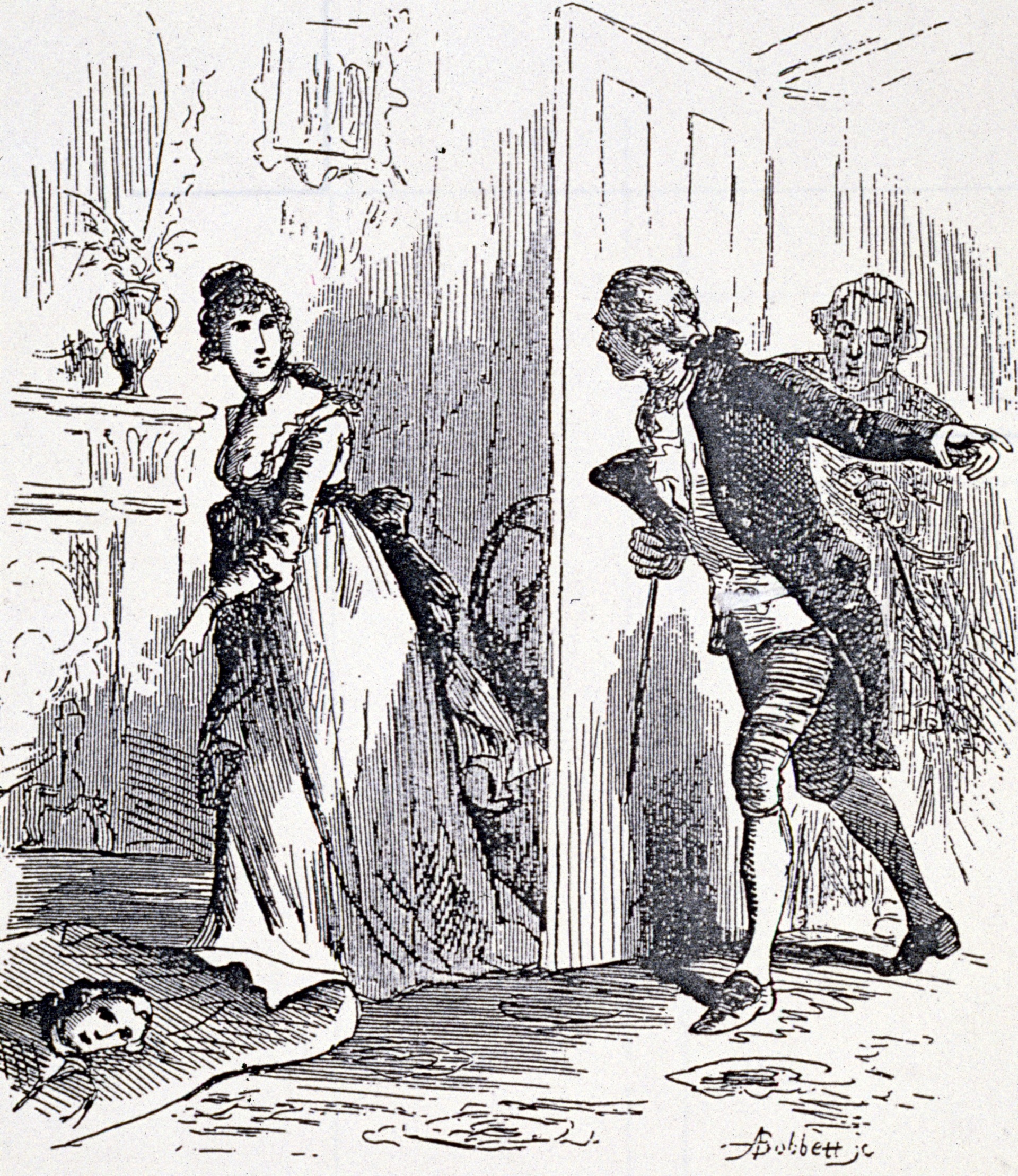
Dolley Madison rescues a portrait of George Washington from the White House before the British troops set fire to the building during the War of 1812. A print by A Bubbett. (Photo by MPI/Getty Images)
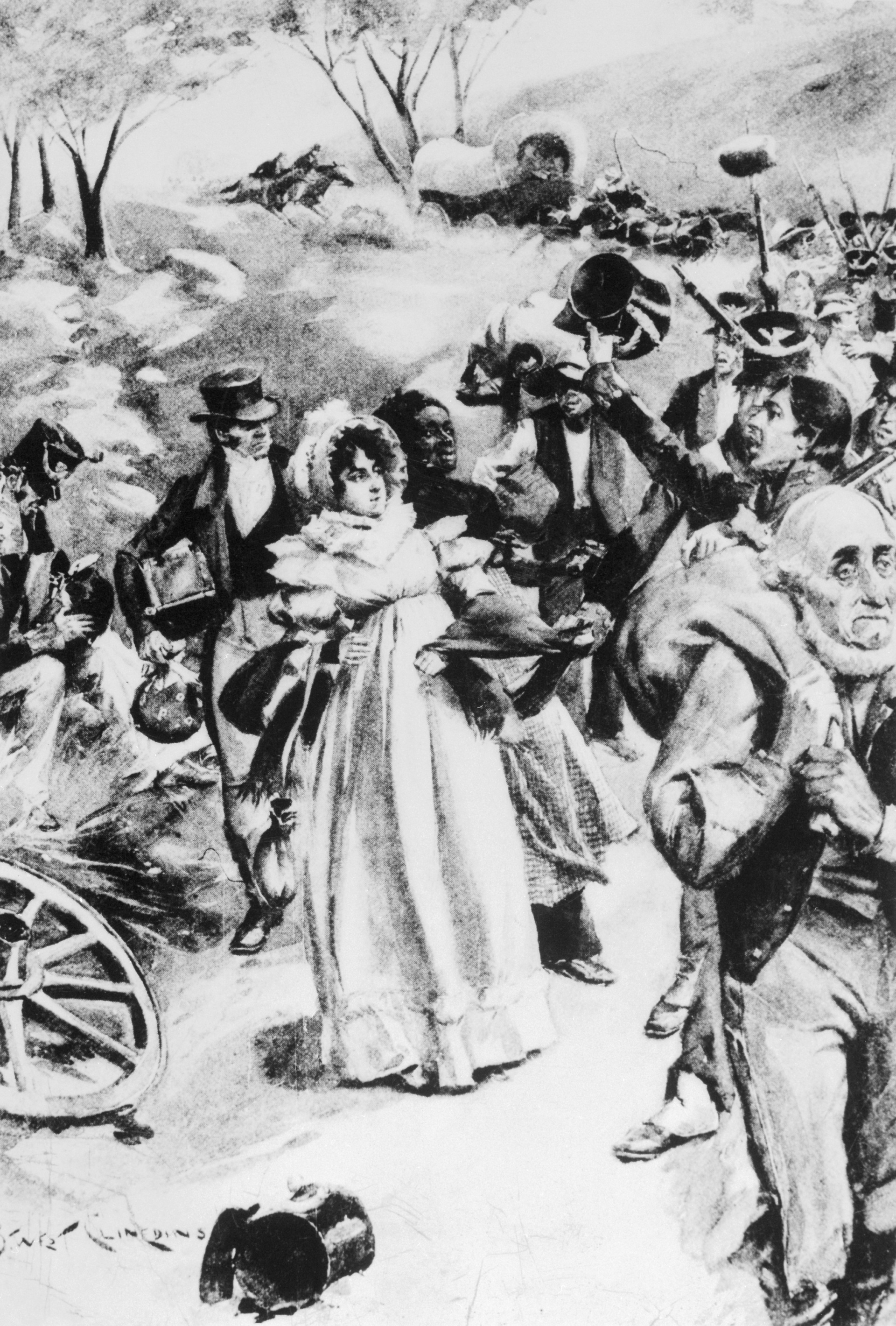
Dolley Madison flees the from the British invasion of Washington, DC, in the War of 1812. (Getty Images)
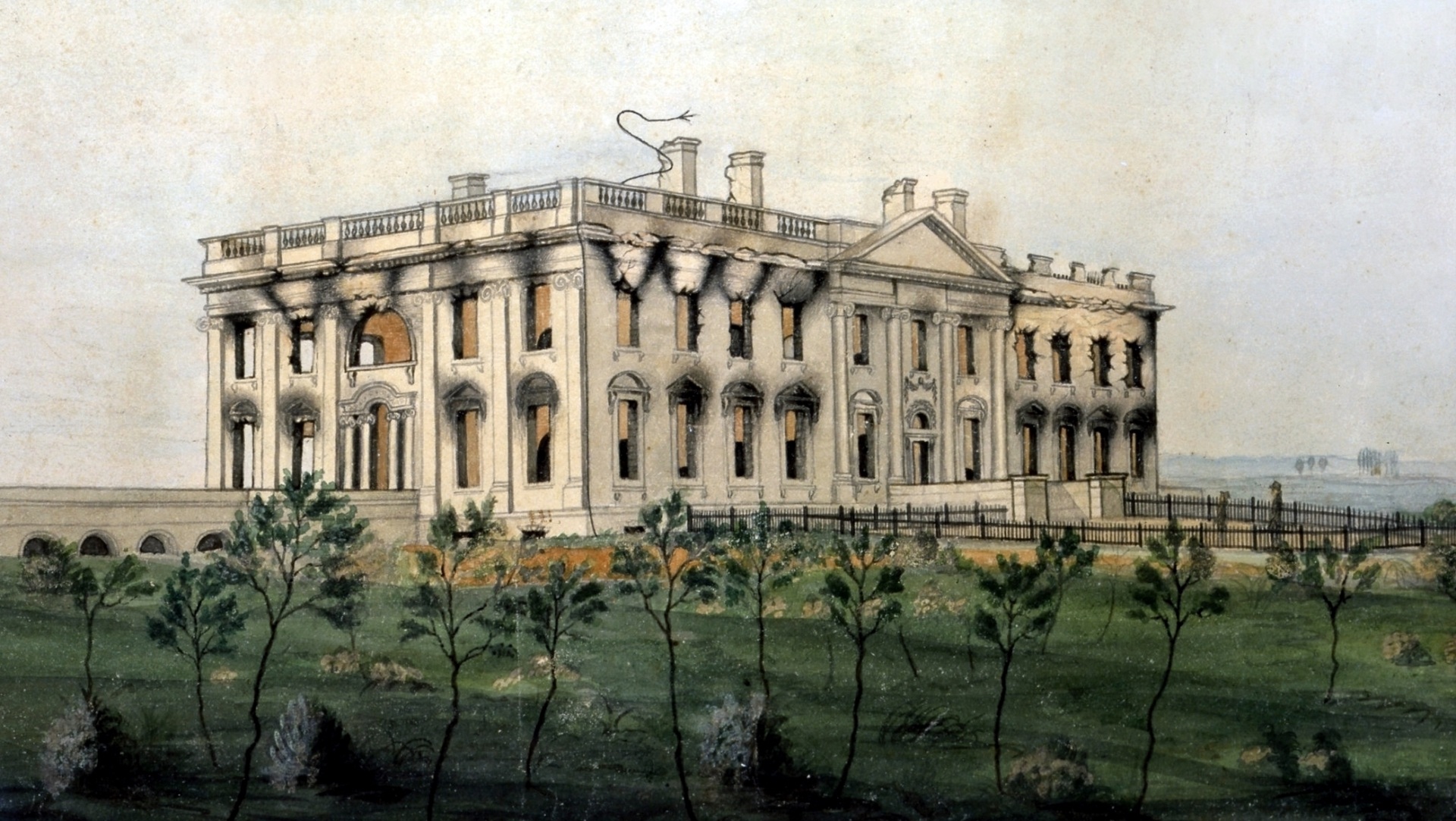
A George Munger painting showing the smoke-filled shell of the White House after it was burned by the British in 1814. All that remained was the charred sandstone exterior. (Wikimedia Commons)
Madison brought back the White House’s original architect, James Hoban, to rebuild it. But it wasn’t finished in time for the Madisons to enjoy it. His successor, James Monroe, was the first president to move back after the fire. Monroe continued the restoration and added the iconic South Portico in 1824.
Old Hickory’s Drunken Hootenanny and Giant Cheese
The botany-loving President John Quincy Adams added an arboretum to the White House grounds, as well as a billiard table to the residency. But his populist successor from the wilds of Tennessee left a bigger imprint on the White House—in more ways than one.
Jackson added the North Portico (for which he was criticized for lavish spending) and installed indoor plumbing. But perhaps his most memorable impact on the structure was the rager he threw for his inauguration.
Jackson–or “Old Hickory” as they called him–was beloved by the “deplorables” of his day, to the horror of the East Coast establishment from the 13 original colonies.
Jackson was the first to really democratize the “People’s House” — in the sense that he invited “the People” inside to celebrate with him. An unruly throng (described by contemporaries as a “mob”) of 20,000 well-wishers followed Jackson to the White House after his swearing-in ceremony. What followed is the stuff of legend, as the White House Historical Association explains:
The surging crowd made mingling impossible, and as people pushed toward Jackson and lunged toward refreshments, they collided with fragile furniture and shoved servants laden with punch bowls and trays of food. Waiters trying to maneuver with a large bowl of spiked orange punch crashed into a crowd and spilled it all on the carpet. Men in work boots, straining to see Jackson, stood on expensive upholstered furniture
The White House servants put tubs of ice cream and whiskey-spiked punch on the lawn in order to lure the crowd out of the building. One senator described the scene as a “regular Saturnalia.”
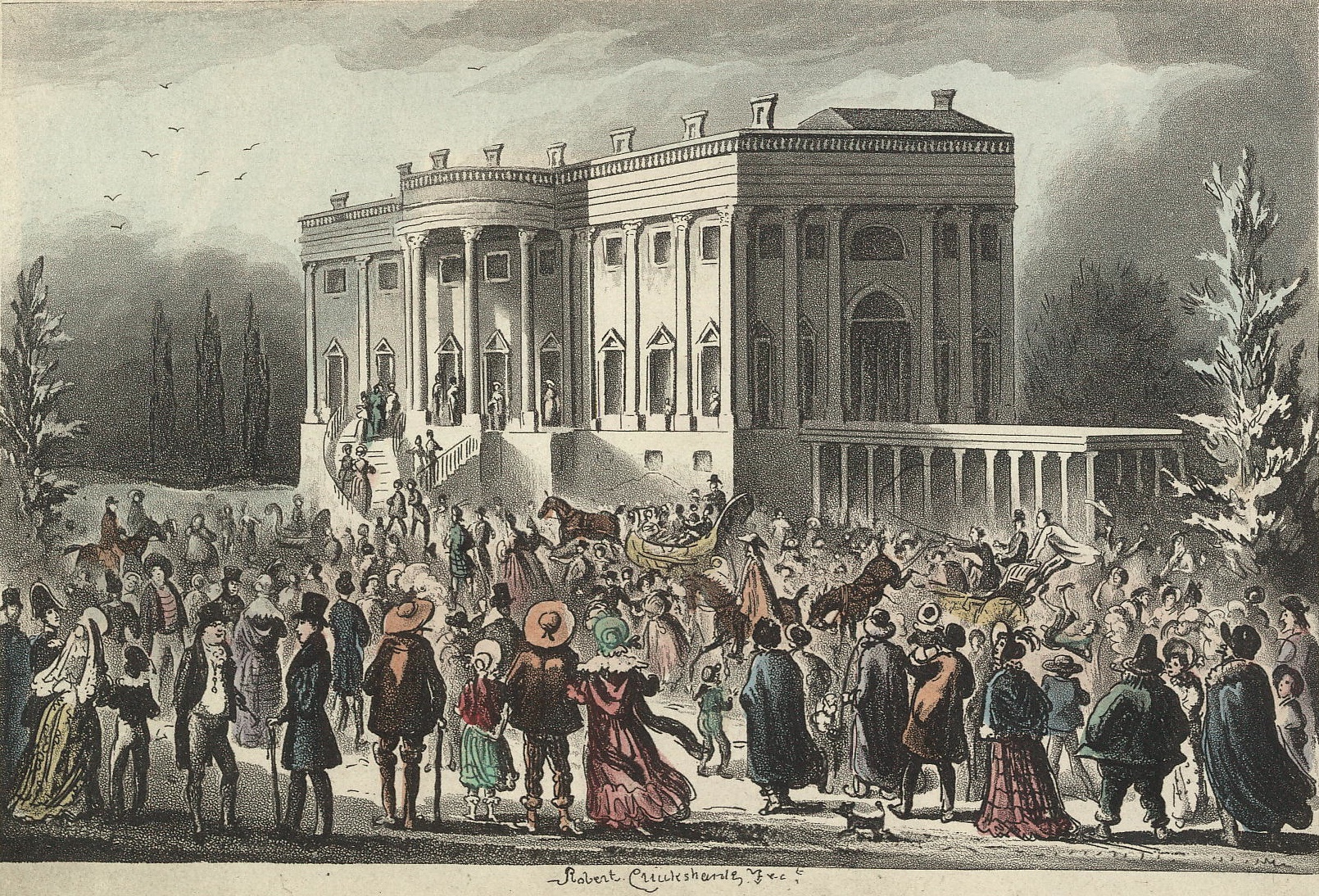
An 1841 depiction of the crowd partying at the White House for Andrew Jackson’s inauguration in 1829. (Library of Congress)
But that wasn’t the last time Old Hickory invited the People to their House for refreshments. In 1835, a New York dairyman gifted Jackson with a 1,400-pound block of cheese. Not knowing what else to do with it, he put it on display in the East Room for two years until the smell was unbearable. He then decided to invite the public in to eat it. (Remember this was before refrigeration!)
The public came in droves, and the cheese was gone in 10 minutes. But the stench of it lingered on for years. President Martin Van Buren—who installed central heating in the White House—was still complaining that the carpet reeked of cheese long after Jackson left office.
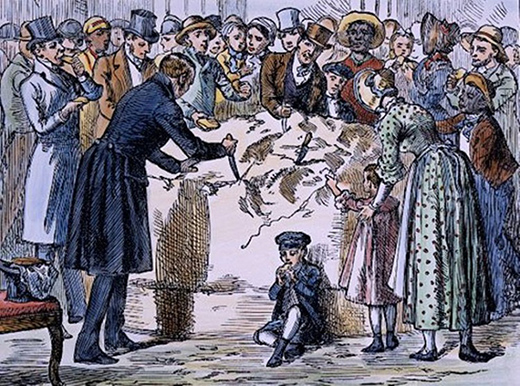
An illustration by Benjamin Perley Poore (1886) depicting the public enjoying Andrew Jackson’s 1,400 pound cheese block at the White House. (The Obama White House/National Archives)
Teddy and His Crazy Kids
The White House had a series of technical and cosmetic upgrades throughout the mid-to-late 19th century. James Polk installed gas lighting. James Buchanan added a glass conservatory in 1857, which burned down in 1867 and was replaced with a larger structure by Andrew Johnson. Rutherford B. Hayes installed the first telephone in 1877. Benjamin Harrison installed electric lighting in 1891.
But by far the most beautiful addition to the White House in late 19th century was the magnificent stained-glass screen that Chester Arthur added to the Entrance Hall in 1882 after commissioning it from the legendary American artist Louis Comfort Tiffany. Alas, the White House’s Tiffany stained-glass screen is lost to history. In one of the worst acts of renovation malfeasance in White House history, Teddy Roosevelt removed the Tiffany screen and sold it at auction. The last remnants of it were likely destroyed in a fire in 1923.
Teddy Roosevelt was the first president to officially name the executive mansion as “The White House.” In 1902, he oversaw one of the most extensive–and often controversial–renovations of the property when he created the East and West Wings.
In the process, however, he demolished the last vestiges of the White House’s Victorian-era decor — from Buchanan and Johnson’s conservatory to Arthur’s Tiffany stained-glass entrance screen. His removal of the latter, in particular, was rightly criticized. His reason for doing it was to return the building to its neoclassical simplicity. But his critics accused him of committing architectural vandalism by prioritizing a doctrinaire belief in architectural theory over the White House’s lived history and heritage.
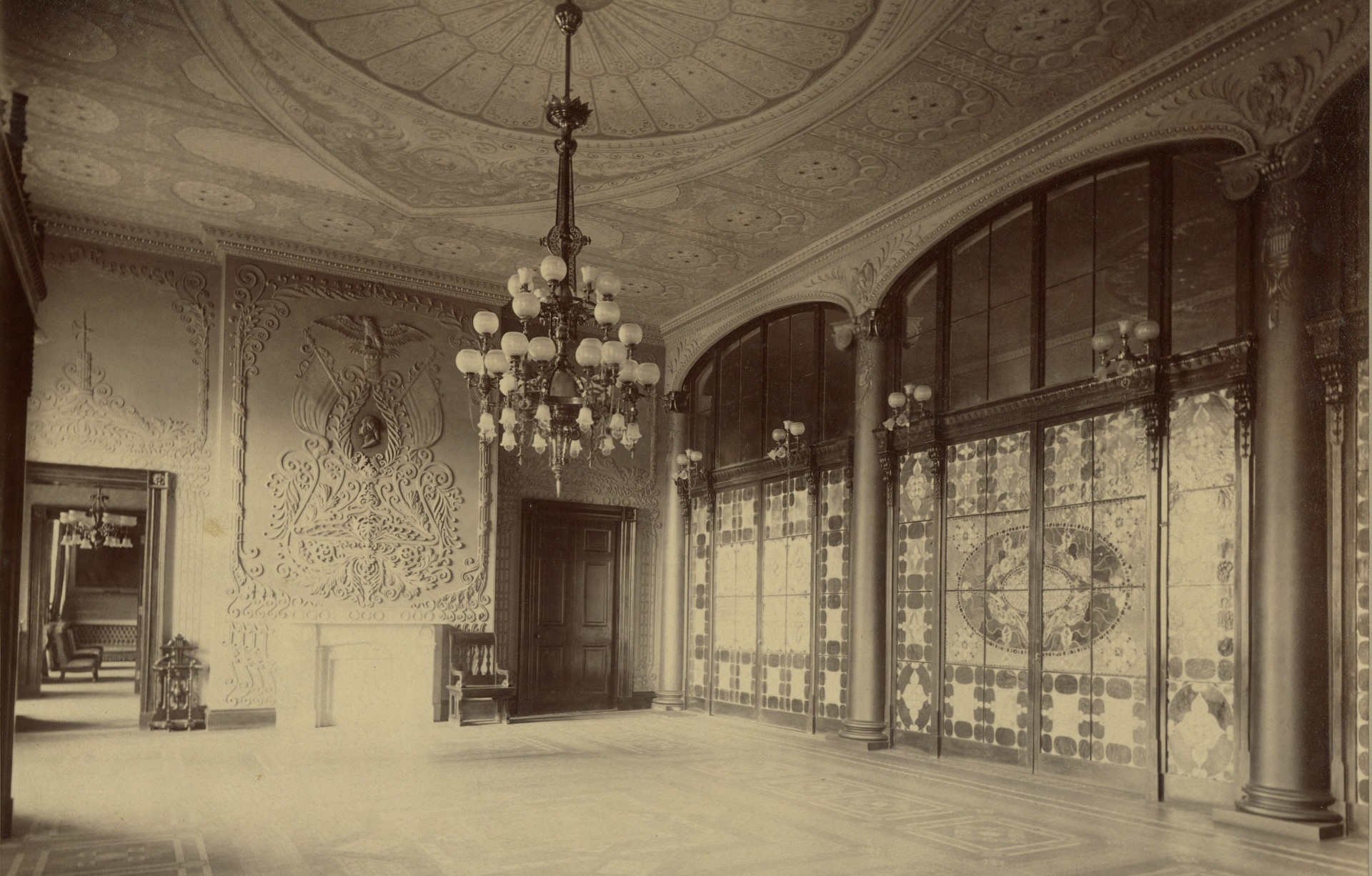
The North Entrance Hall of the White House showing Chester Arthur’s Tiffany stained-glass screen, circa 1890s. Teddy Roosevelt removed the stained-glass in 1902 and complete redid the room. (Wikimedia Commons)

White House conservatory, circa 1890, which was destroyed by Teddy Roosevelt in 1902. (Heritage Art/Heritage Images via Getty Images)
It should be noted that Teddy’s large young family and their exotic pets (a hyena, a pony, a lizard, an owl, a one-legged rooster, and multiple snakes) were not gentle with the People’s property.
Case in point: the time when young Kermit and Quentin Roosevelt took their pet pony Algonquin upstairs in the White House (via the elevator) so that he could visit their brother Archie who was sick in bed.
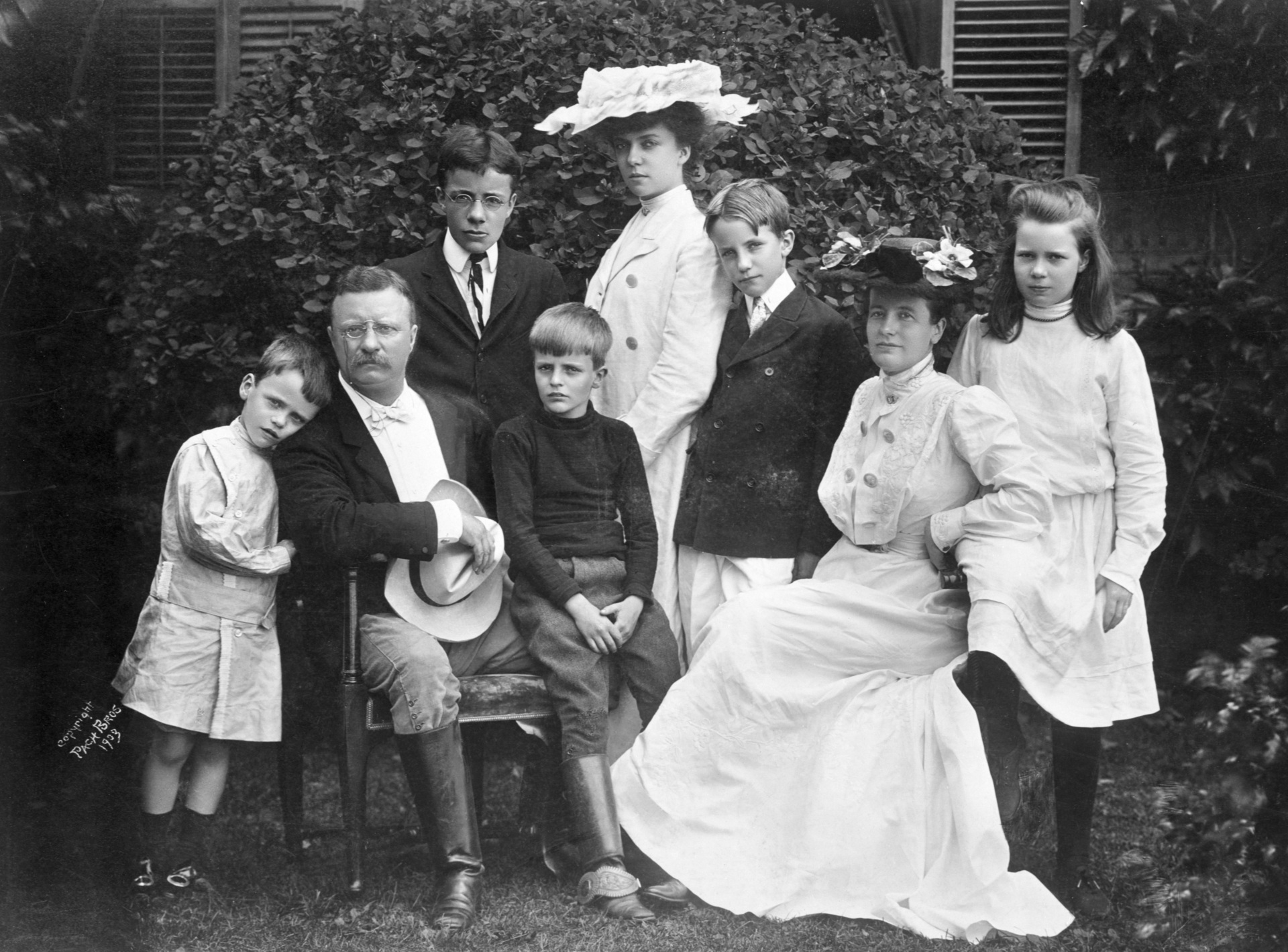
President Theodore Roosevelt with his family circa 1903. From left to right: Quentin, Theodore Sr., Theodore Jr. (with glasses), Archie, Alice, Kermit, Mrs. Roosevelt, and Ethel. (Pach Brothers/CORBIS/Corbis via Getty Images)
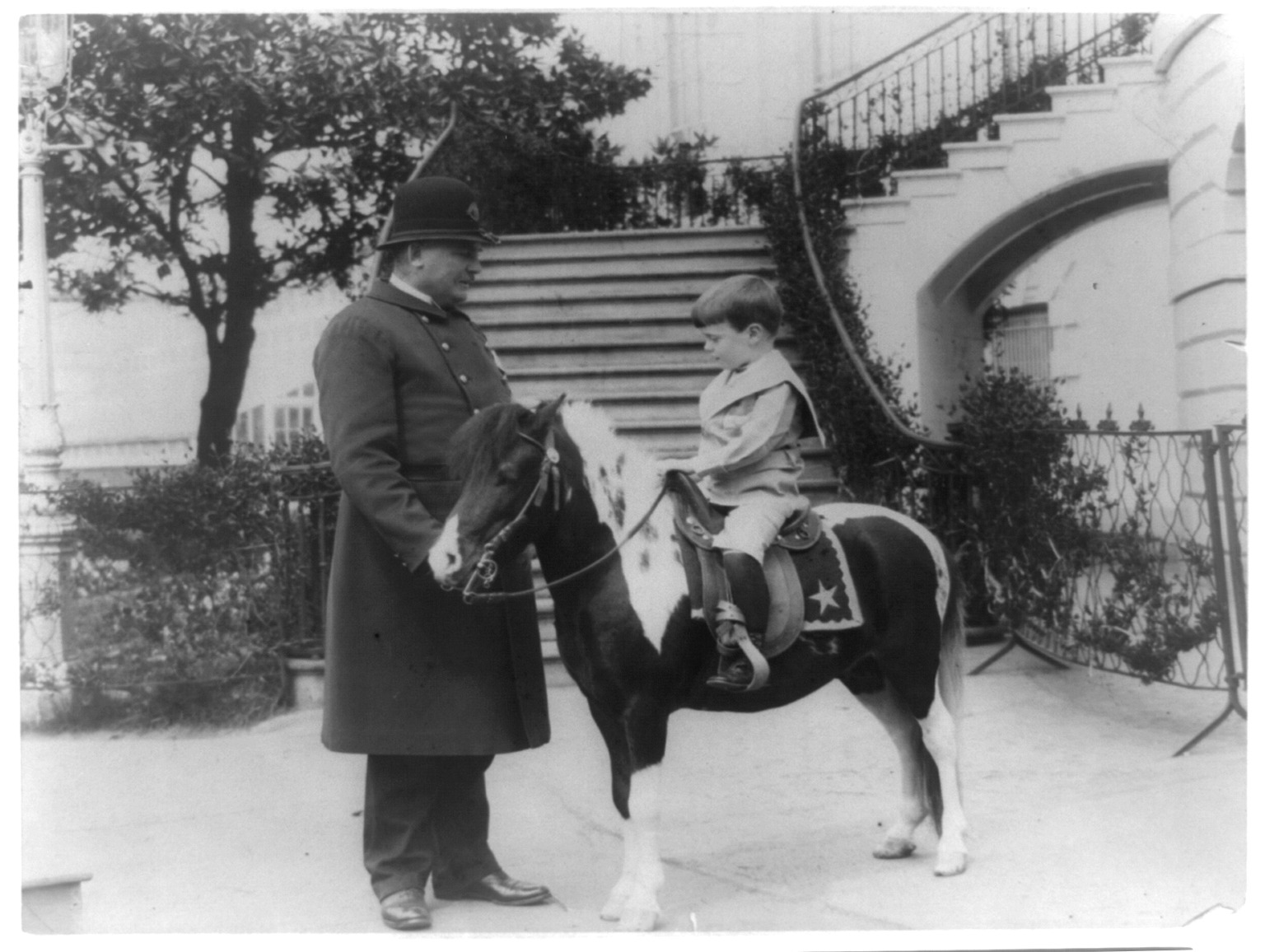
Quentin Roosevelt on a pony beside White House policeman, 1905. Artist Frances Benjamin Johnston. (Photo by Heritage Art/Heritage Images via Getty Images)
William Howard Taft continued Teddy’s West Wing expansion and created the first variation of the Oval Office. Woodrow Wilson added some guest rooms and a painting studio. Calvin Coolidge did major work on the roof and attic and added the third floor of the residence as well as the solarium over the South Portico.
Warren G. Harding’s Closet
The scandal-plagued President Warren G. Harding didn’t add much to the White House grounds, but he did have sex with his mistress, Nan Britton, in a White House closet.
After Harding died in office, Nan spilled the beans about their six-year affair and the illegitimate daughter they conceived in a tell-all book titled The President’s Daughter.
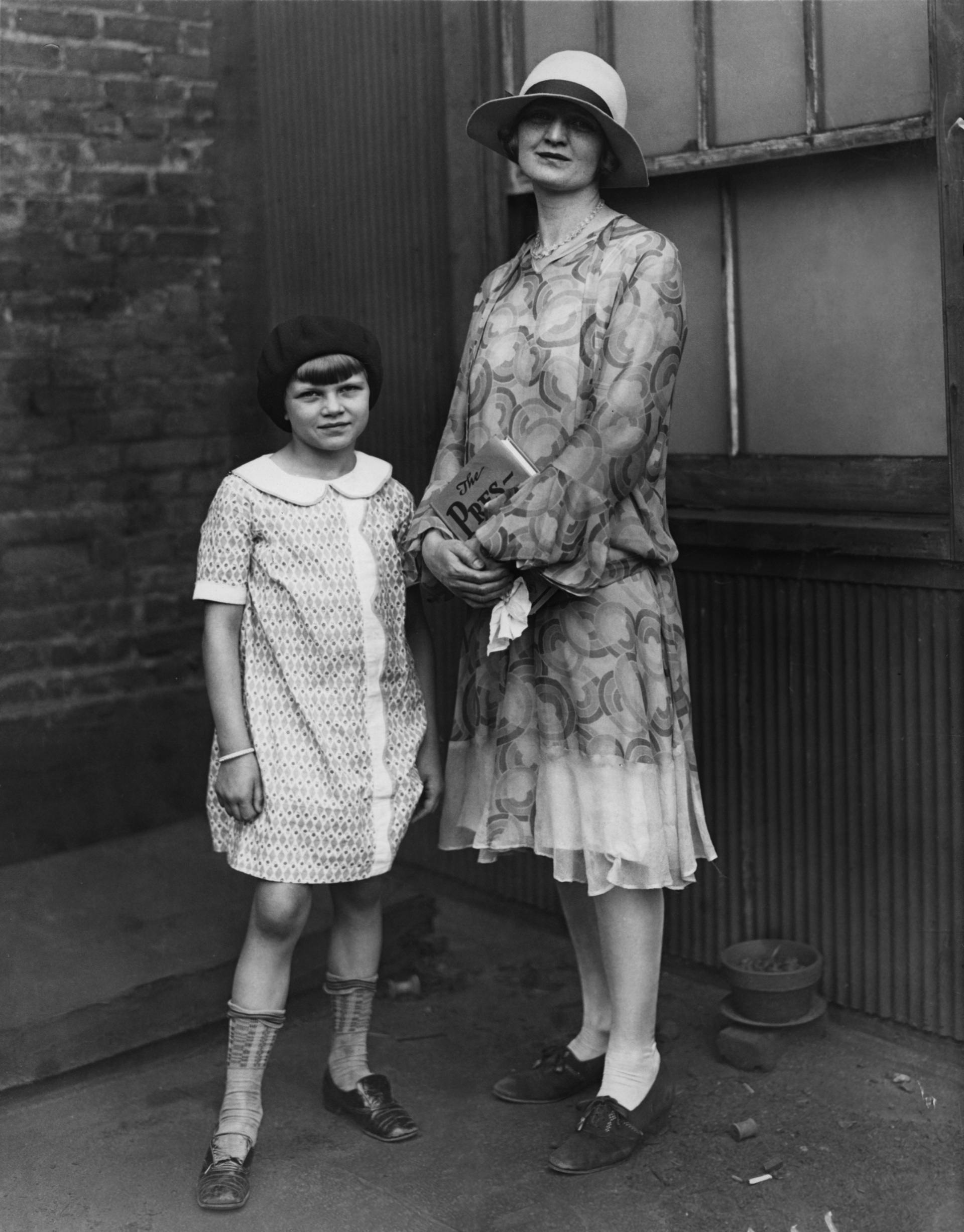
Nan Britton poses in 1927 with her daughter, Elizabeth, who was fathered illegitimately by President Warren G. Harding during one his many trysts with Nan in the White House. (Soibelman Syndicate Collection/Visual Studies Workshop/Getty Images)
The Stock Market Crashed… And the White House Burned
The White House burned yet again during Herbert Hoover’s presidency, when a fire destroyed a large portion of the West Wing on Christmas Eve 1929—just two months after the Stock Market Crash. Was it a metaphor for the state of the country? Large portions of the roof and the interior had to be replaced.
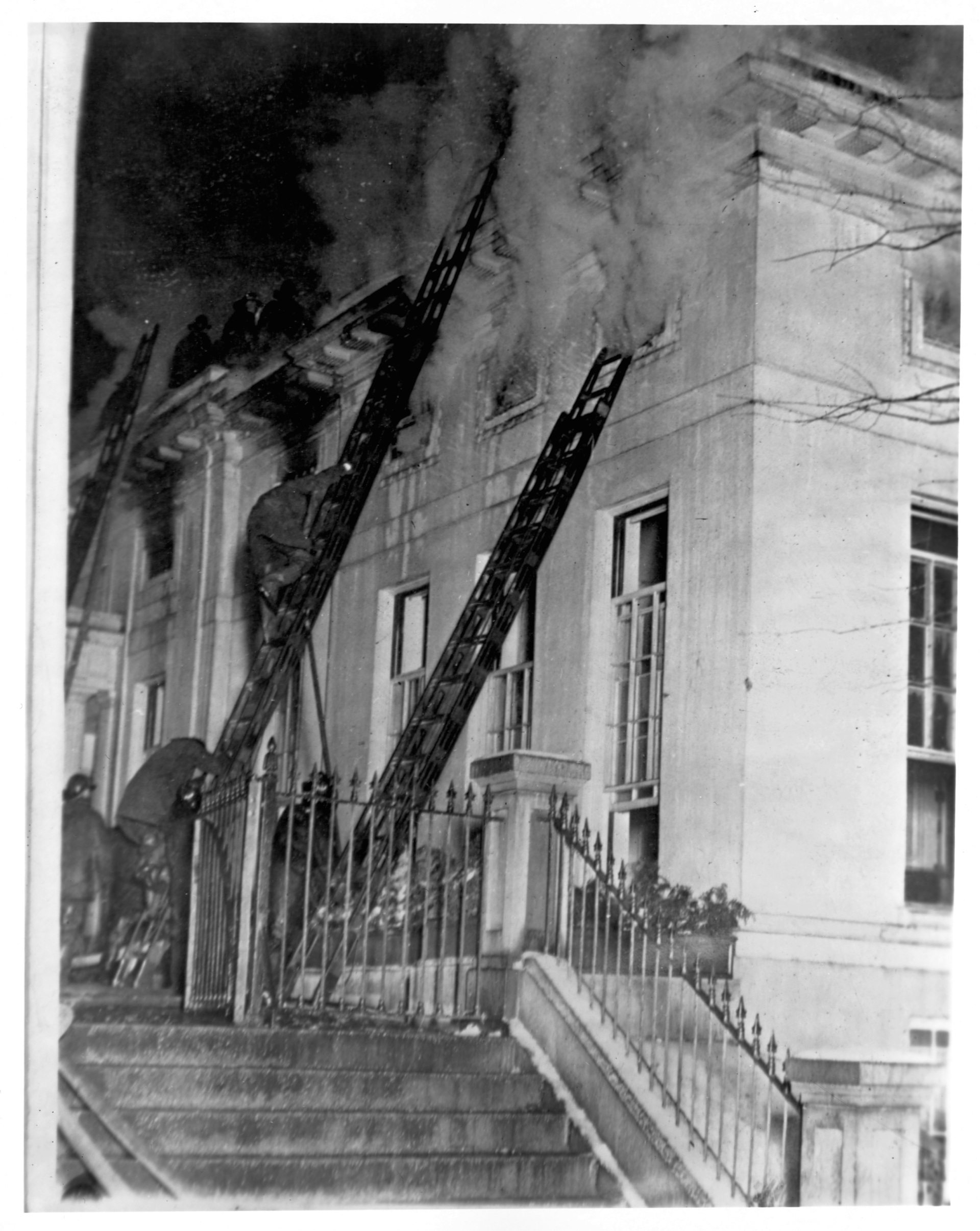
Two firefighters climb a ladder to fight a fire at the White House on December 24, 1929. (H.E. French/Library of Congress/Corbis/VCG via Getty Images)
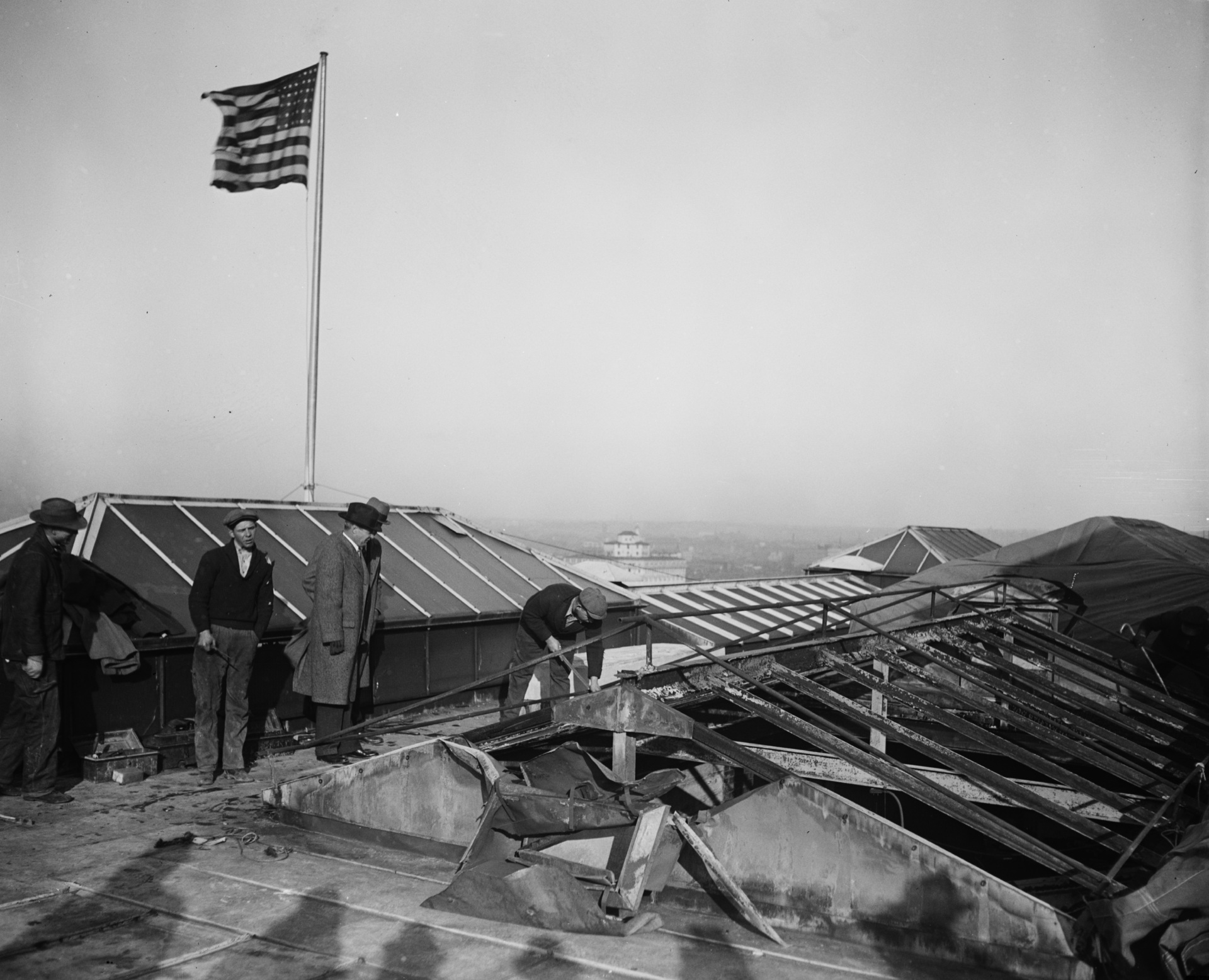
Workers inspect the roof of the White House in January 1930, to review the damage from a Christmas Eve fire. (Library of Congress/Interim Archives/Getty Images)
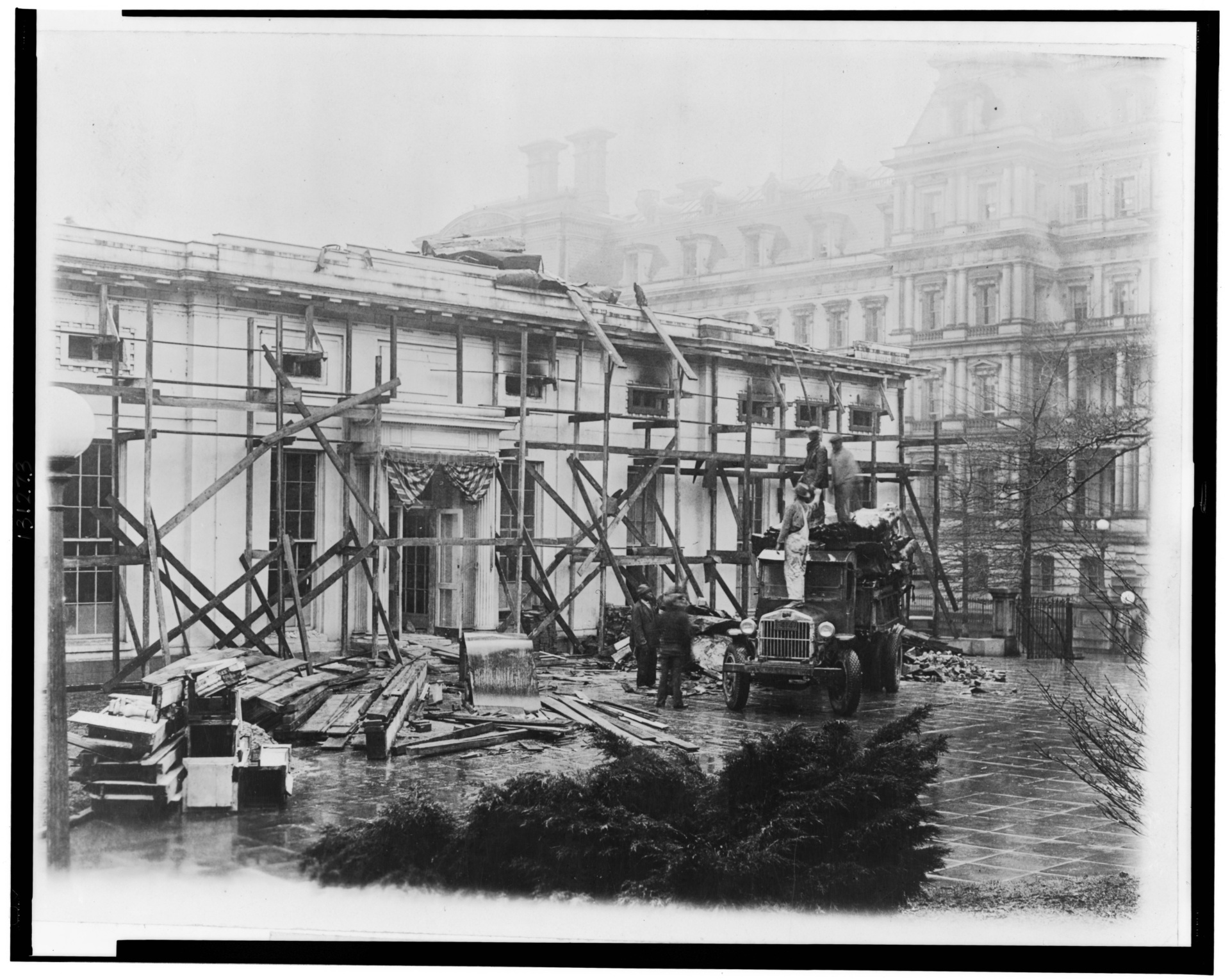
The White House’s executive offices undergo repairs in 1930 following the Christmas Eve fire. (Library of Congress)
Though the country was gripped by the Great Depression, happy days were here again at the White House with the election of Franklin Delano Roosevelt.
FDR expanded the West Wing and moved the Oval Office to its current location in the southeast corner overlooking the Rose Garden.
In 1942, he rebuilt the East Wing as part of a World War II project to conceal the construction of an underground emergency shelter. The East Wing would eventually be used for the First Lady’s staff and as a public entrance for guests and tourists.
And one more thing… the polio-afflicted FDR enjoyed swimming as part of his physical therapy. So, his supporters donated the funds to build him an indoor swimming pool at the White House.
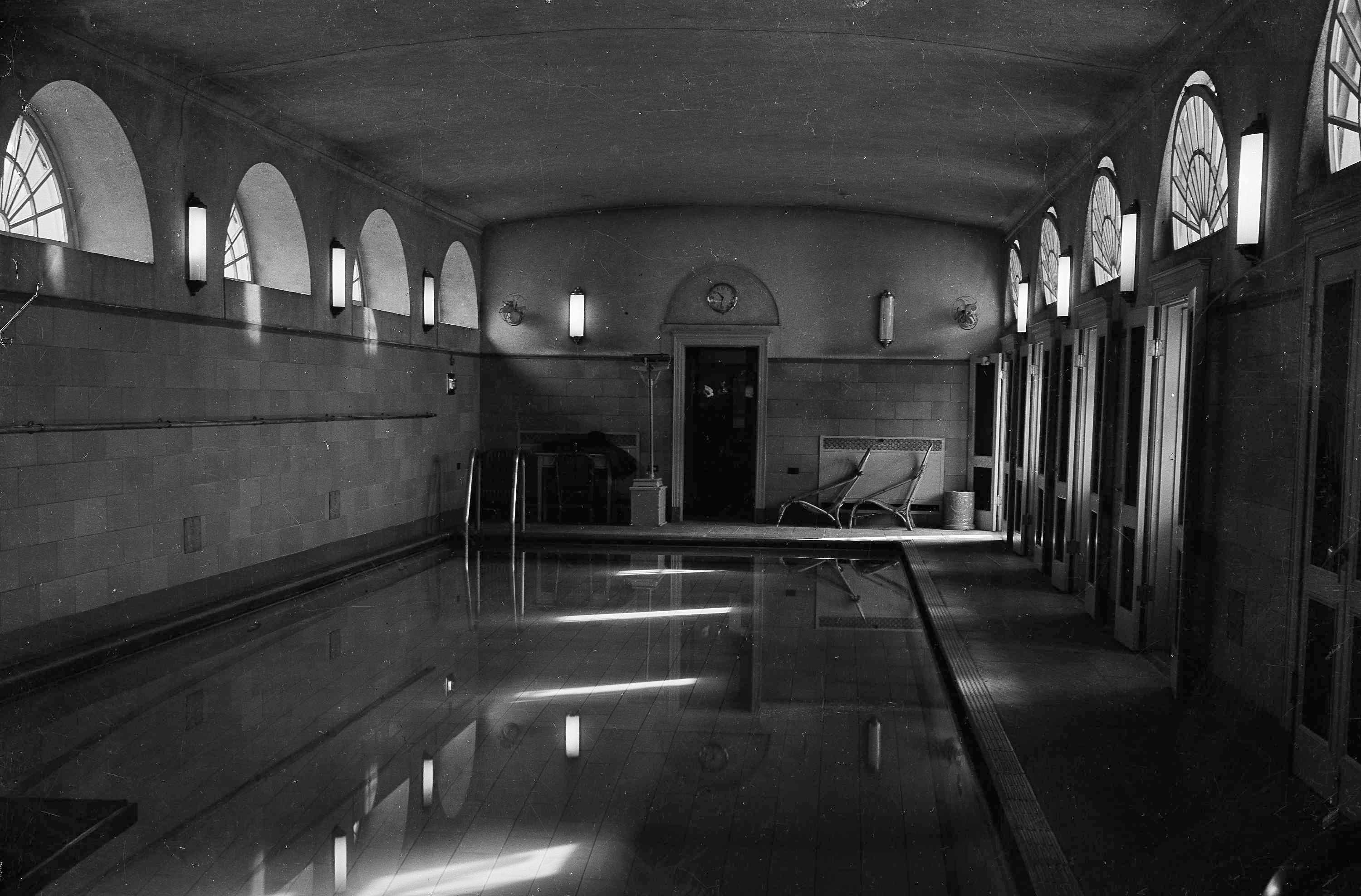
This is a swimming pool interior shot of the Presidents Swimming Pool in the White House, Jan. 26, 1938, Washington, D.C. (AP Photo)
During his 1,036-day presidency, John F. Kennedy really enjoyed FDR’s indoor swimming pool—and so did the staffers who joined him there for afternoon sexual romps.
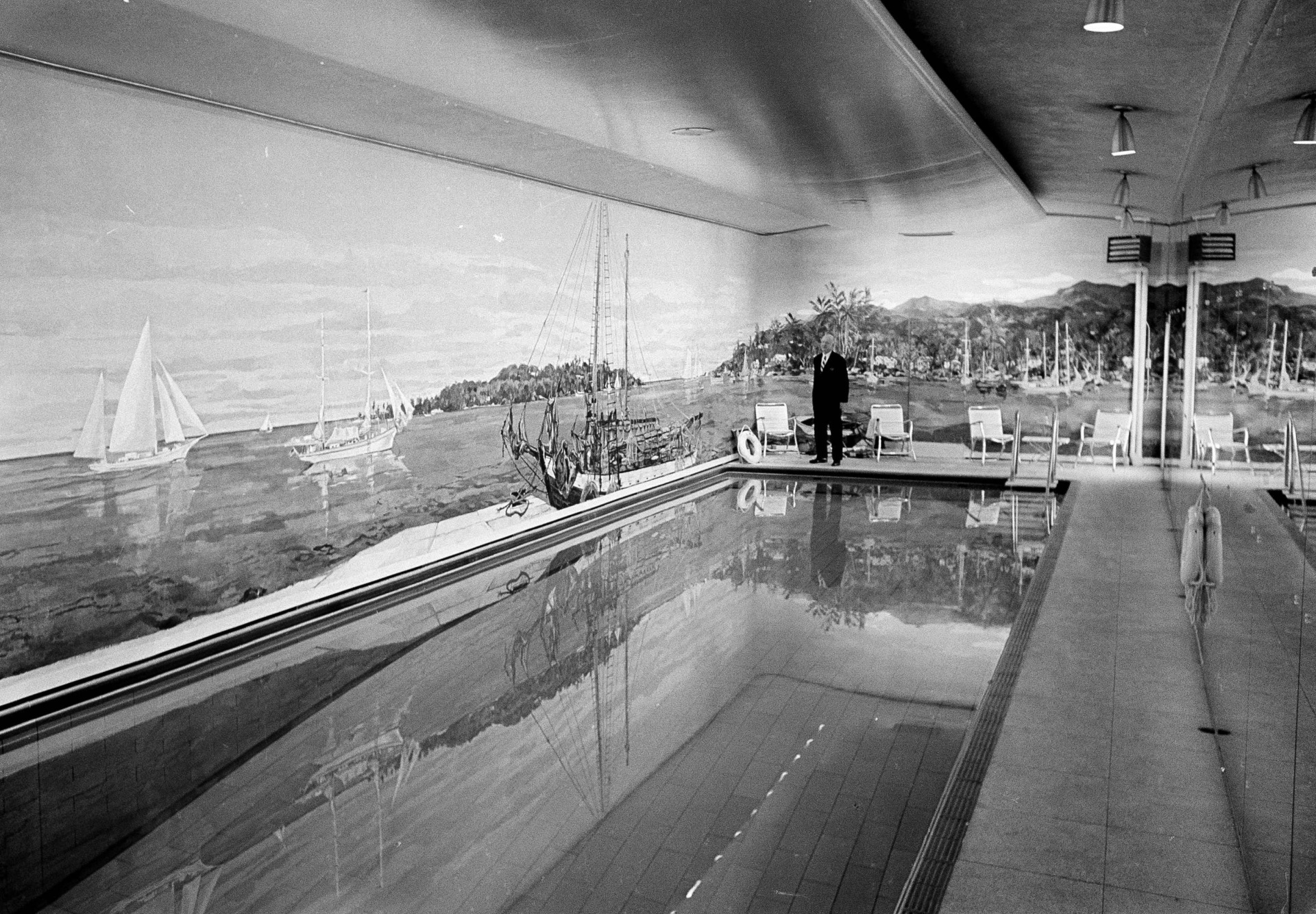
The White House indoor swimming pool as it appeared in April 1965, during the Kennedy era. (AP Photo)
Give ‘Em Hell Harry Gutted the Whole Damn Thing and Started from Scratch
The White House you see today is an architectural recreation initiated by President Harry S. Truman.
When “Give ‘Em Hell” Harry entered the People’s House, the place was falling apart.
“The damned place is haunted, sure as shootin,” Truman wrote in a letter to his wife, Bess, in September 1946. “You and Margie had better come back and protect me before some of these ghosts carry me off.”
For the next two years, Harry, Bess, and their daughter Margaret (“Margie”) tried to keep the ghosts at bay. But the ceilings were dangerously cracking, the chandeliers were ominously swaying, and the floorboards creaked so badly that Harry worried his bathtub would come crashing down on the floor below him every time he bathed.
Then, in 1948, a leg on Margaret’s piano punched through her sitting room floor and into the dining room ceiling below. That did it. The White House was no longer “habitable.” Congress authorized $5.4 million for a major renovation, and of course controversy followed.
This was not just a little touch-up job. The building was structurally unsound. Harry had to gut the whole damn thing and start practically from scratch. Most of the interior was stripped.
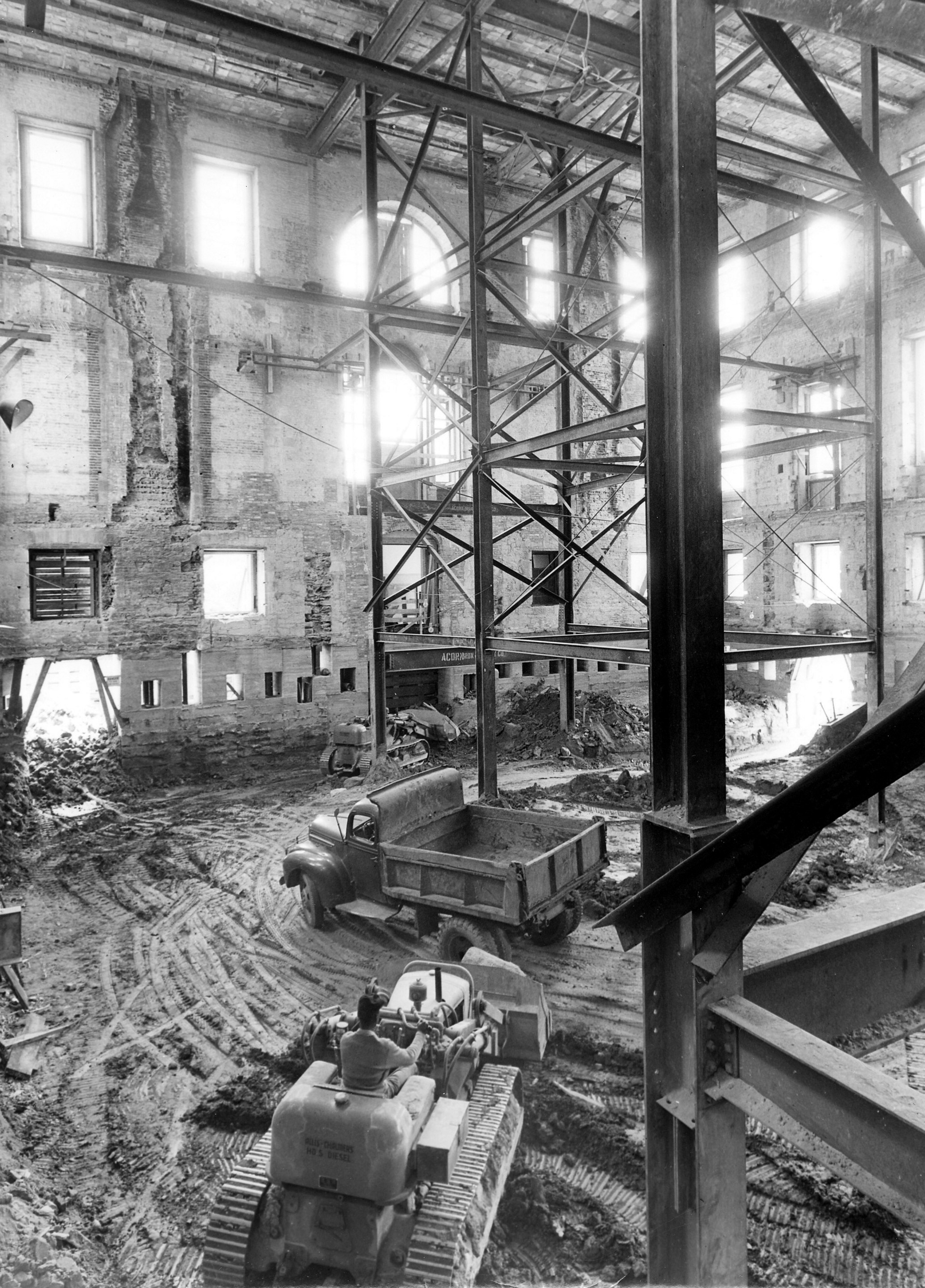
The shell of the White House during Truman’s renovation on May 17, 1950. (Smith Collection/Gado/Getty Images).
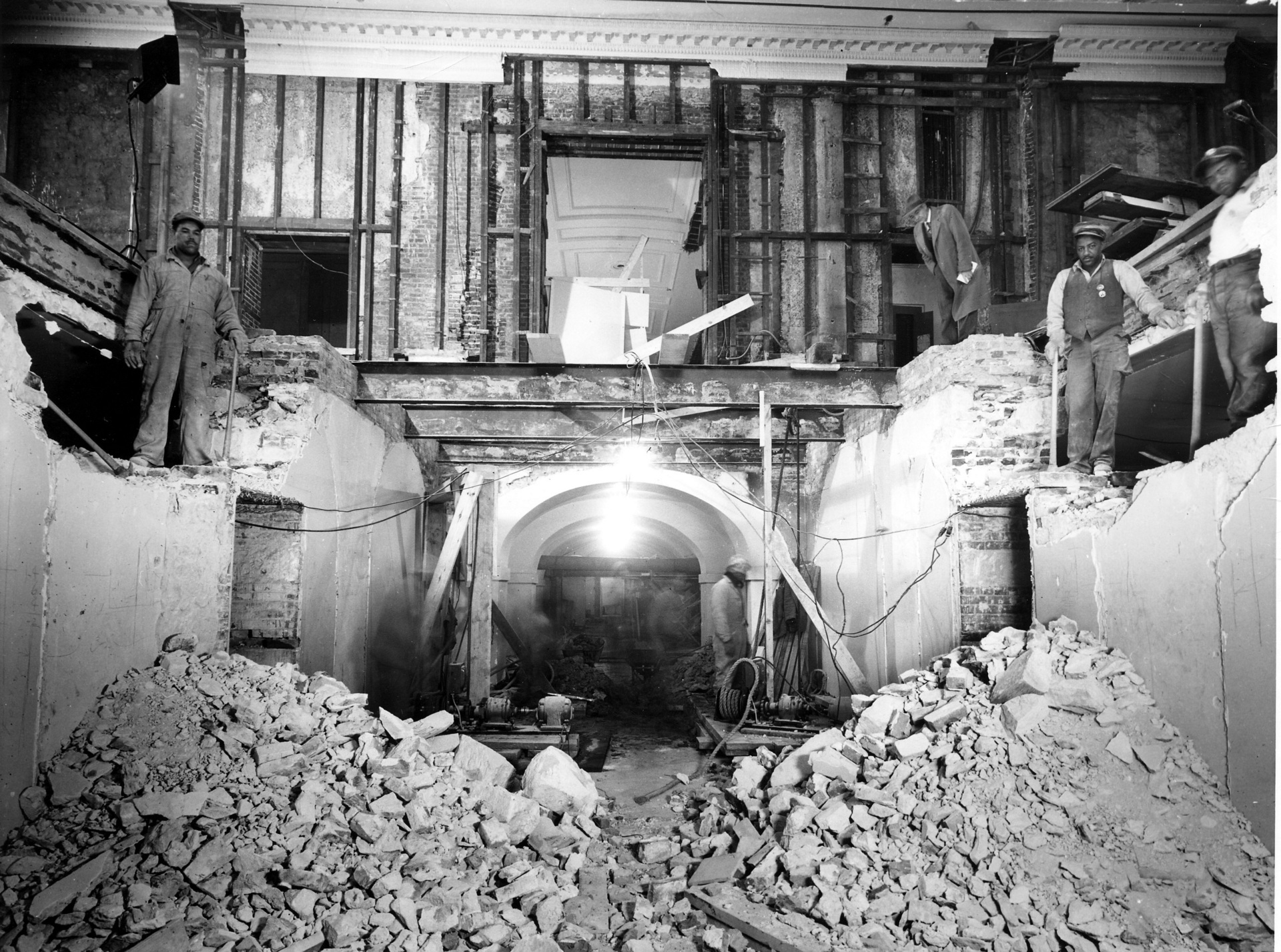
Several men pose amid partially demolished walls, rubble and steel girders in the lower corridor of the White House during President Truman’s White House Reconstruction on February 14, 1950. (Smith Collection/Gado/Getty Images)
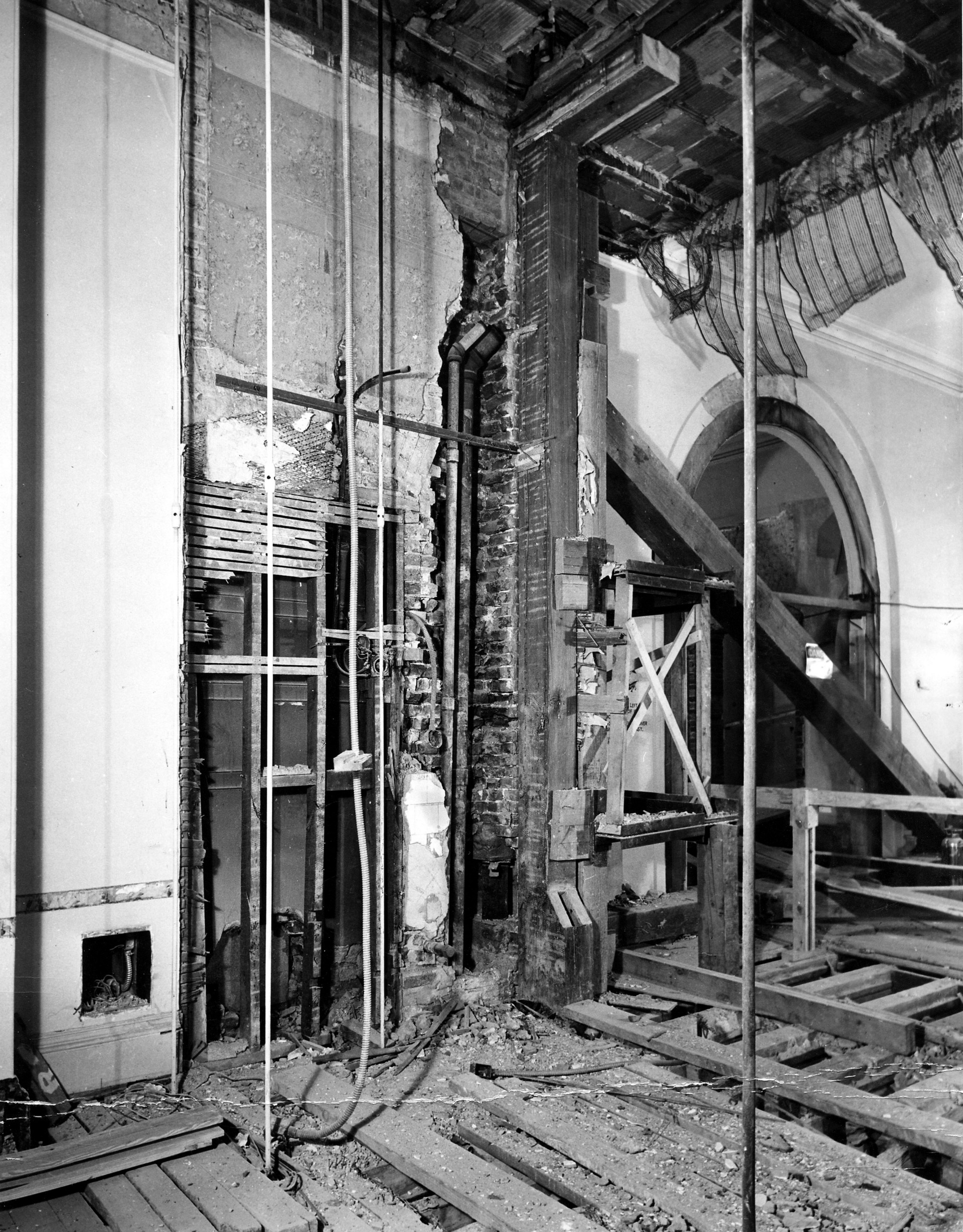
Southeast view, from the Yellow Bathroom into the corridor, revealing a weakened support column, during President Truman’s White House Reconstruction in 1950. (Smith Collection/Gado/Getty Images)
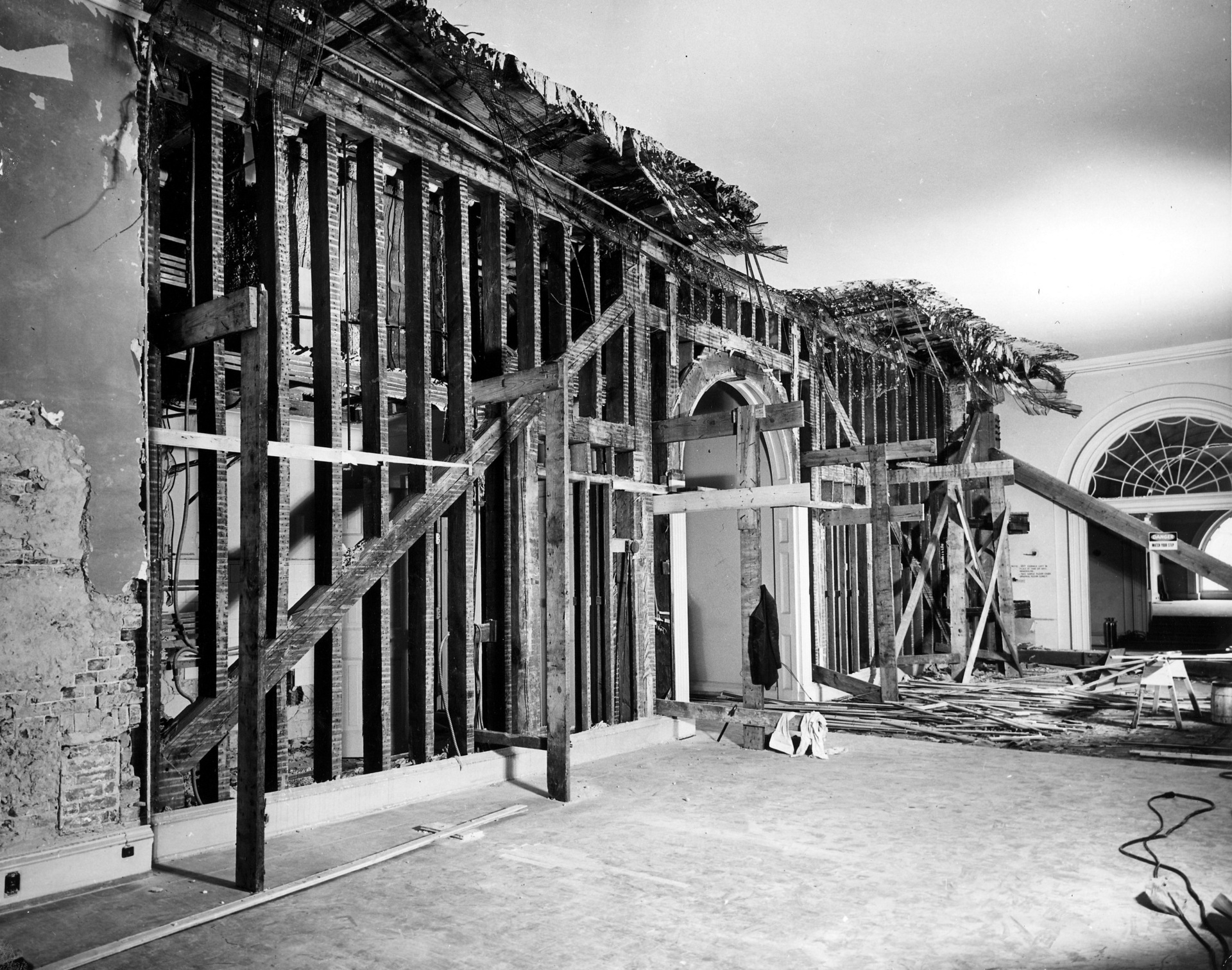
Angled view of nineteenth-century timber construction in the second-floor corridor of the White House, revealed during President Truman’s White House Reconstruction on January 3, 1950. (Smith Collection/Gado/Getty Images)
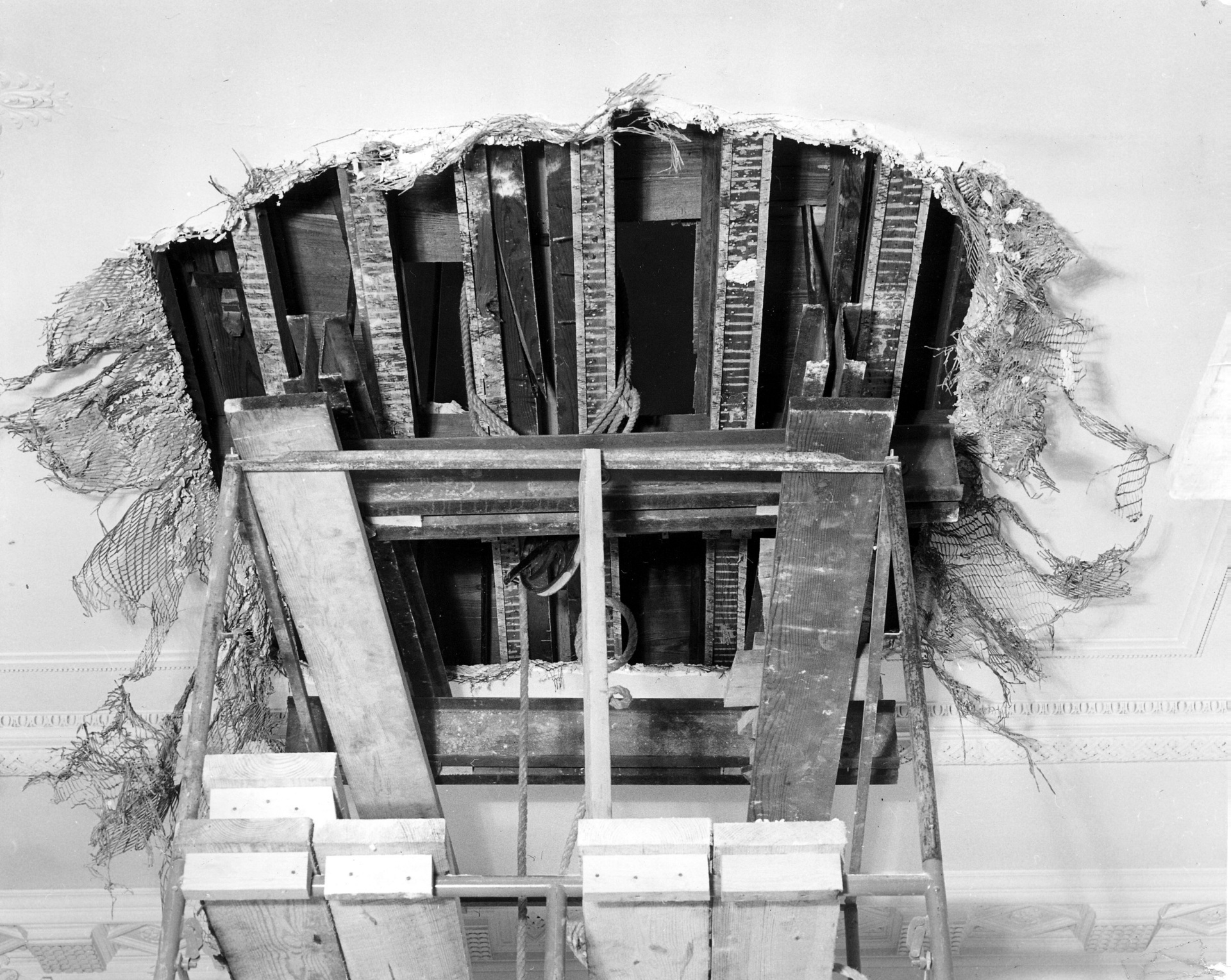
Low angle view of a split beam in the White House lobby’s ceiling, discovered during President Truman’s White House Reconstruction on January 25, 1950. (Smith Collection/Gado/Getty Images)
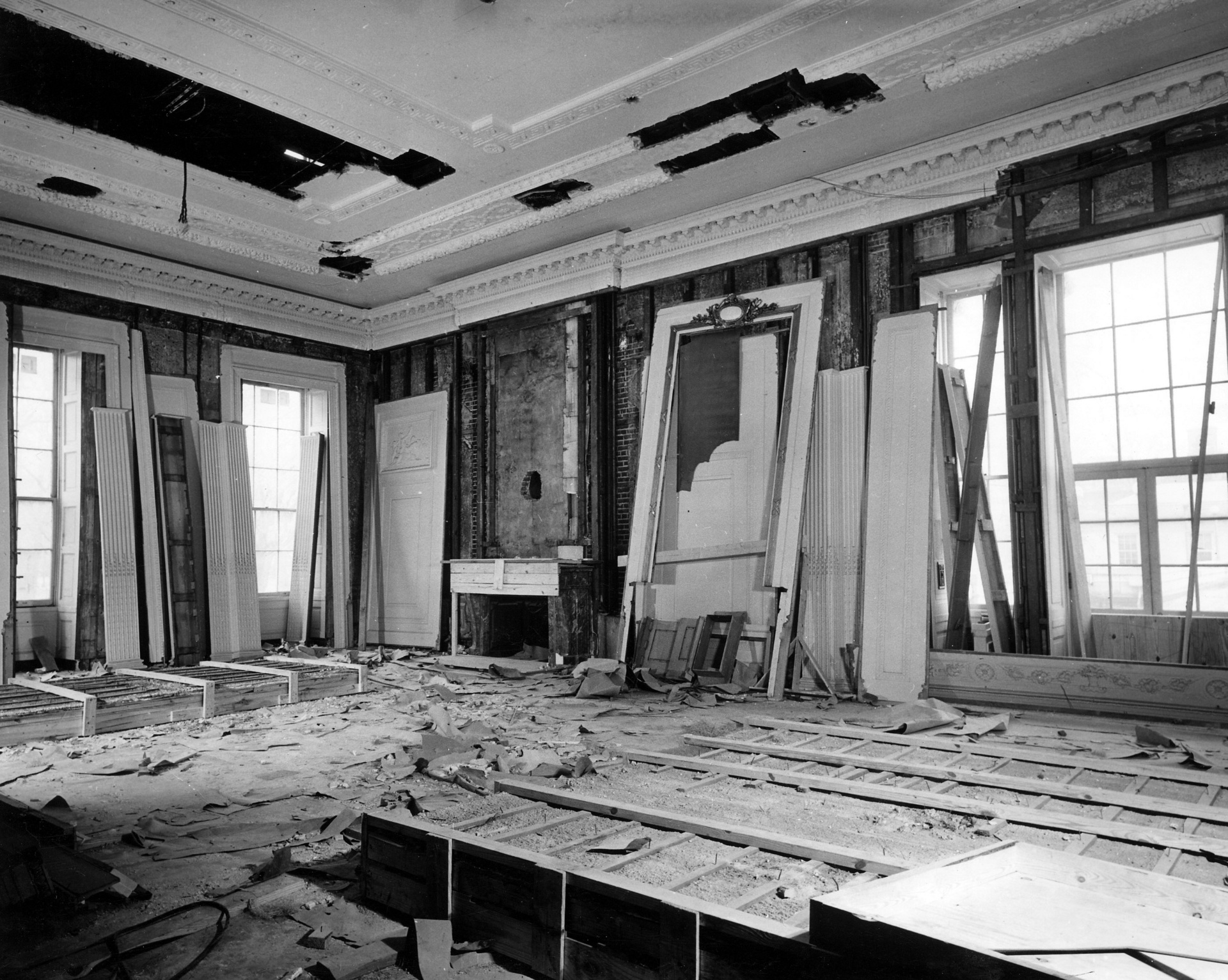
Angled view of the East Room, filled with loose paneling, framing, and building debris, during President Truman’s White House Reconstruction on January 19, 1950. (Smith Collection/Gado/Getty Images)
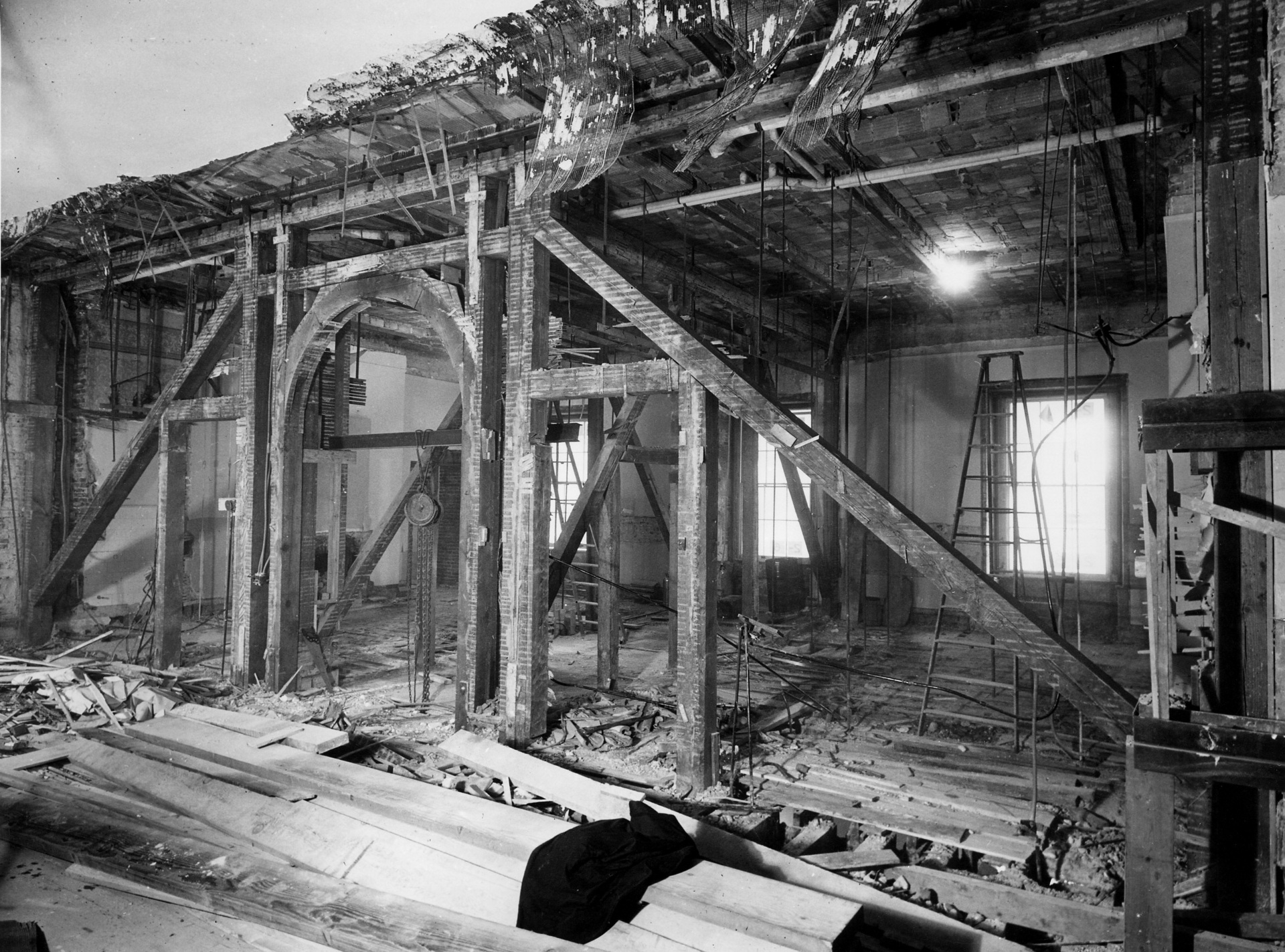
Angled view of exposed trusswork in the north wall of the White House’s second-floor corridor, photographed during President Truman’s White House Reconstruction on February 9, 1950. (Smith Collection/Gado/Getty Images)
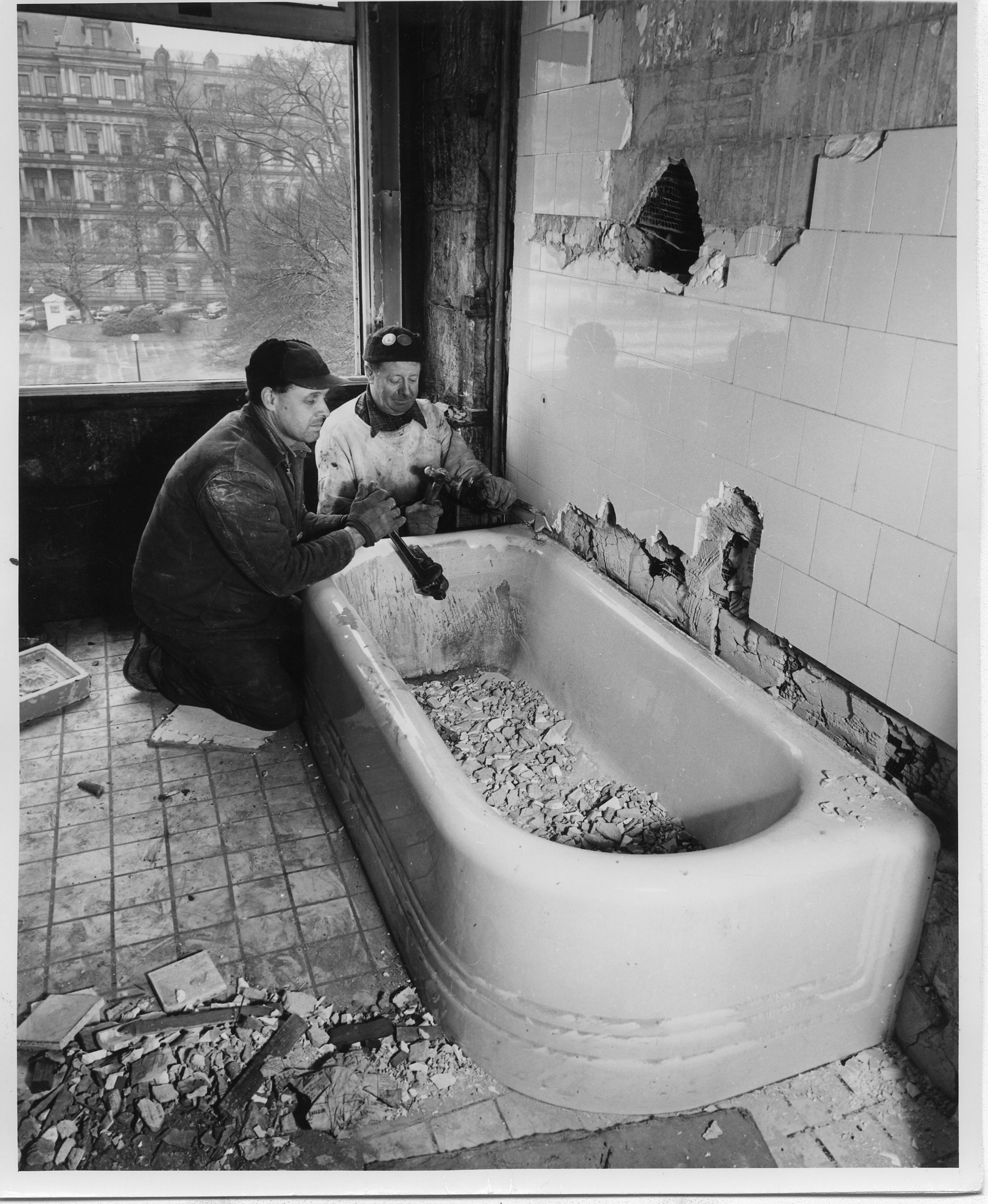
Two workmen dismantle a bathtub, in a northwest corner room on the second floor the White House, during President Truman’s White House Reconstruction on February 10, 1950. (Smith Collection/Gado/Getty Images)
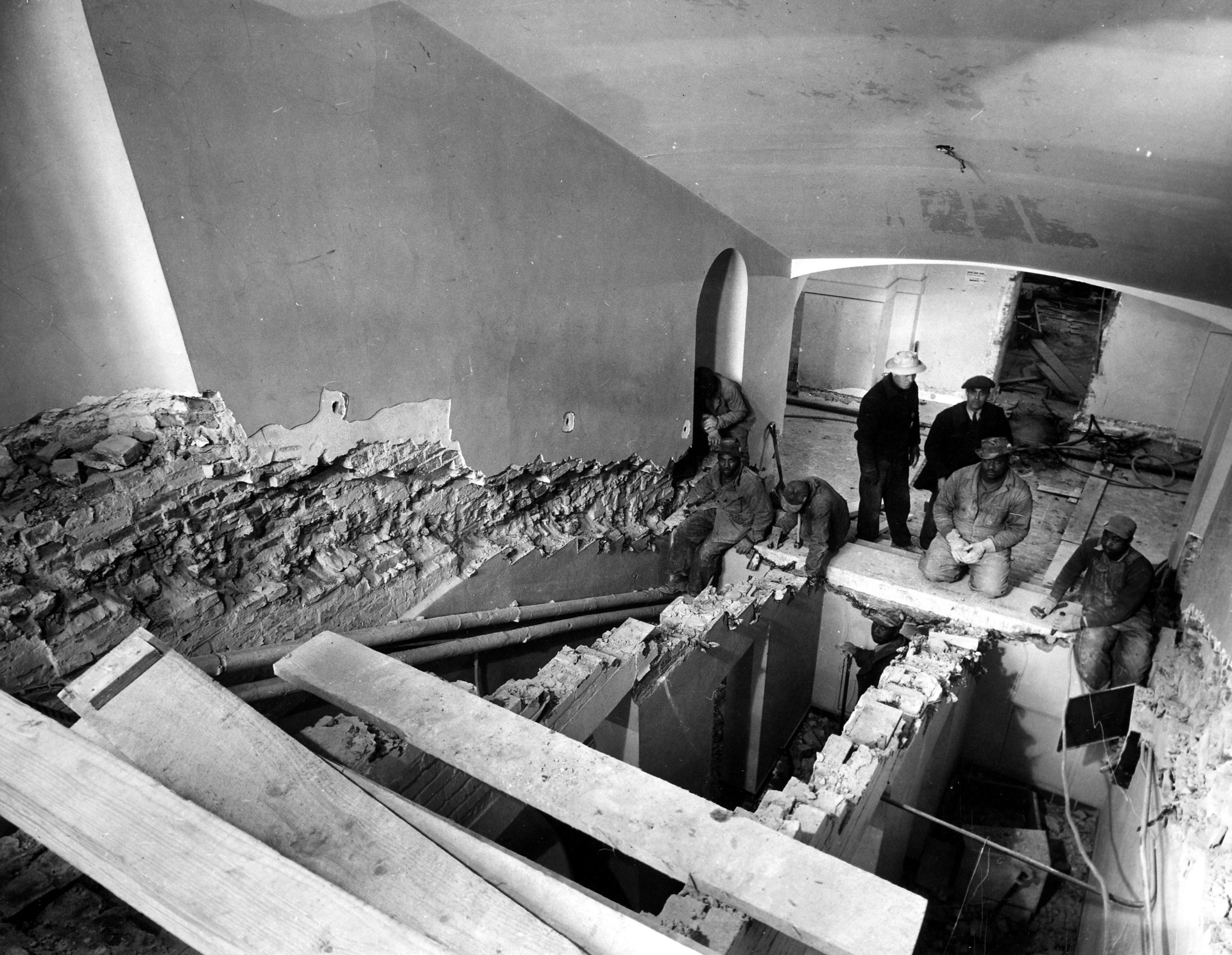
High angle view, from the first-floor landing to the basement, of workmen removing Joliet stone steps from the main stairway, during President Truman’s White House Reconstruction on February 23, 1950. (Smith Collection/Gado/Getty Images)
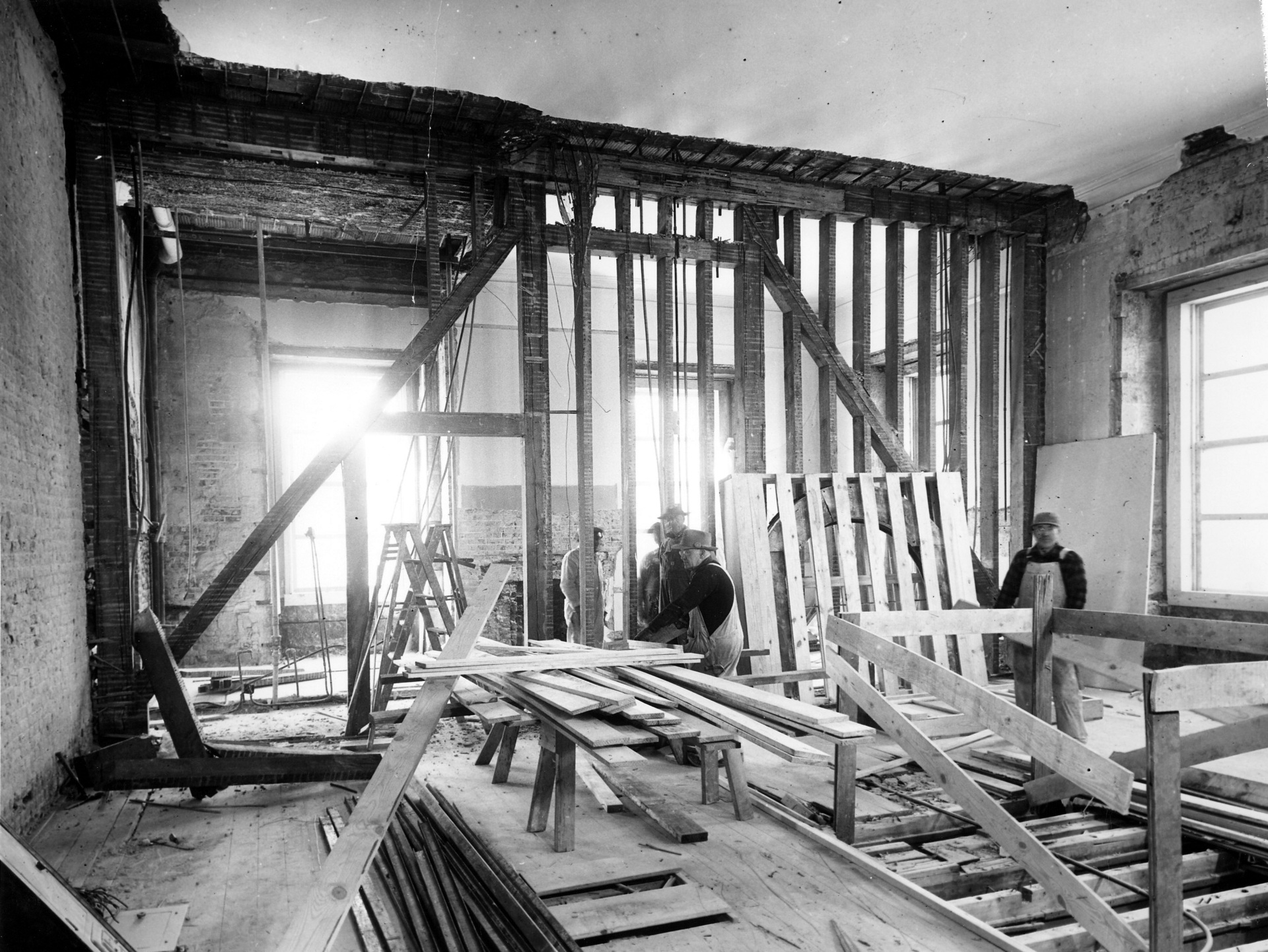
Bedroom and sitting room of the White House during Truman’s renovation on February 27, 1950. (Smith Collection/Gado/Getty Images).
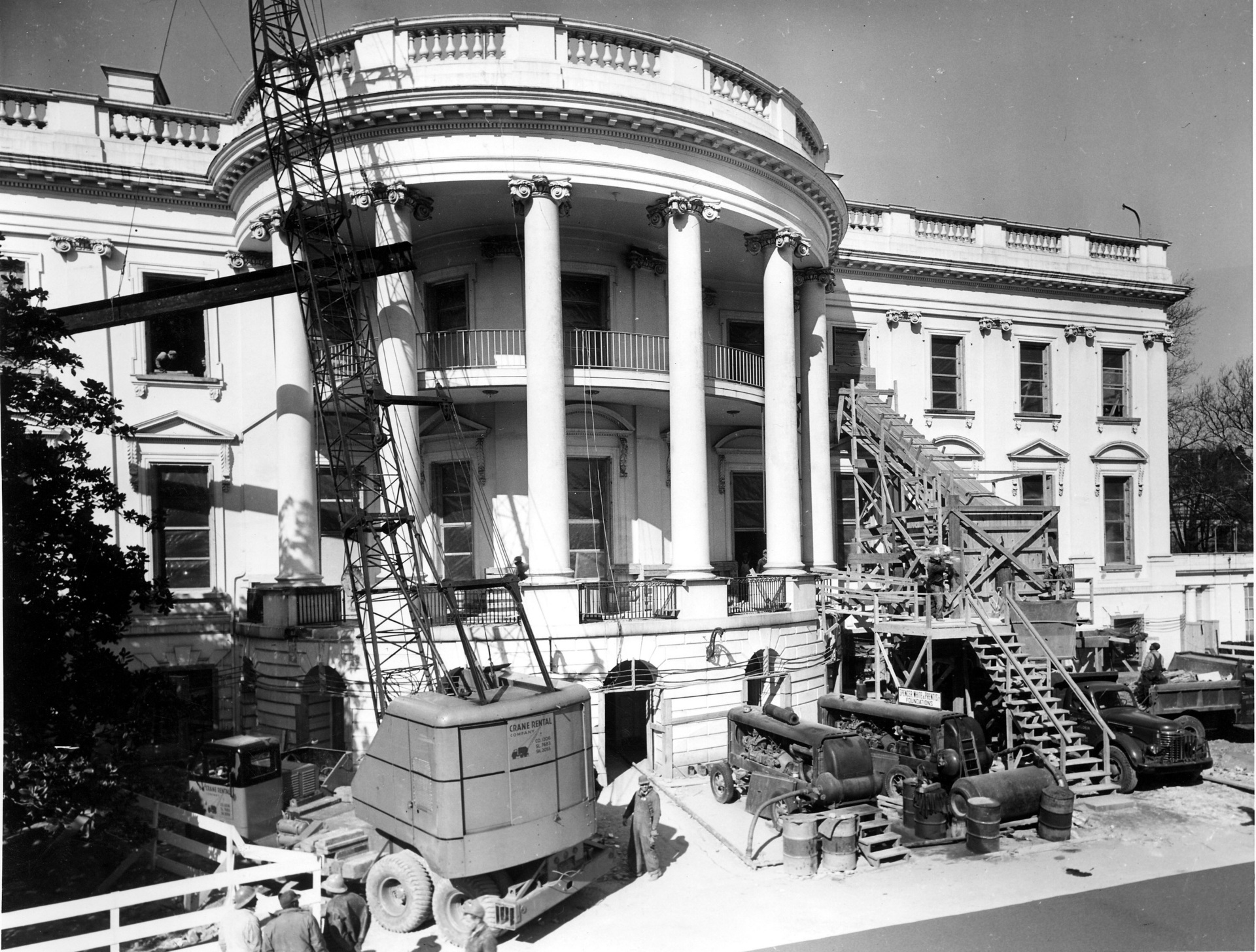
Workers remove debris from the renovation of the White House on February 27, 1950. (Smith Collection/Gado/Getty Images).
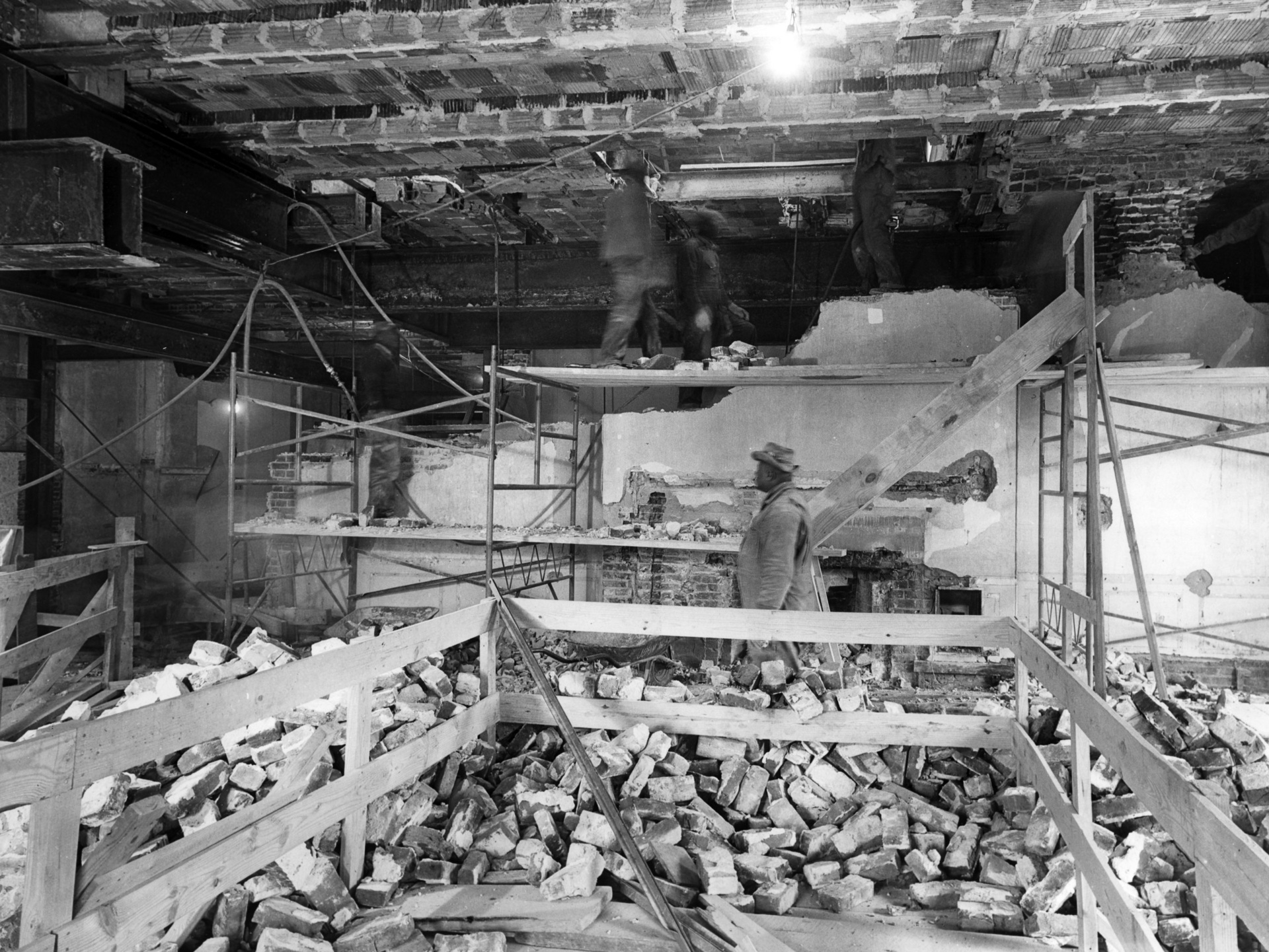
Workmen remove a wall of the White House during renovation on April 12, 1950. (Smith Collection/Gado/Getty Images).
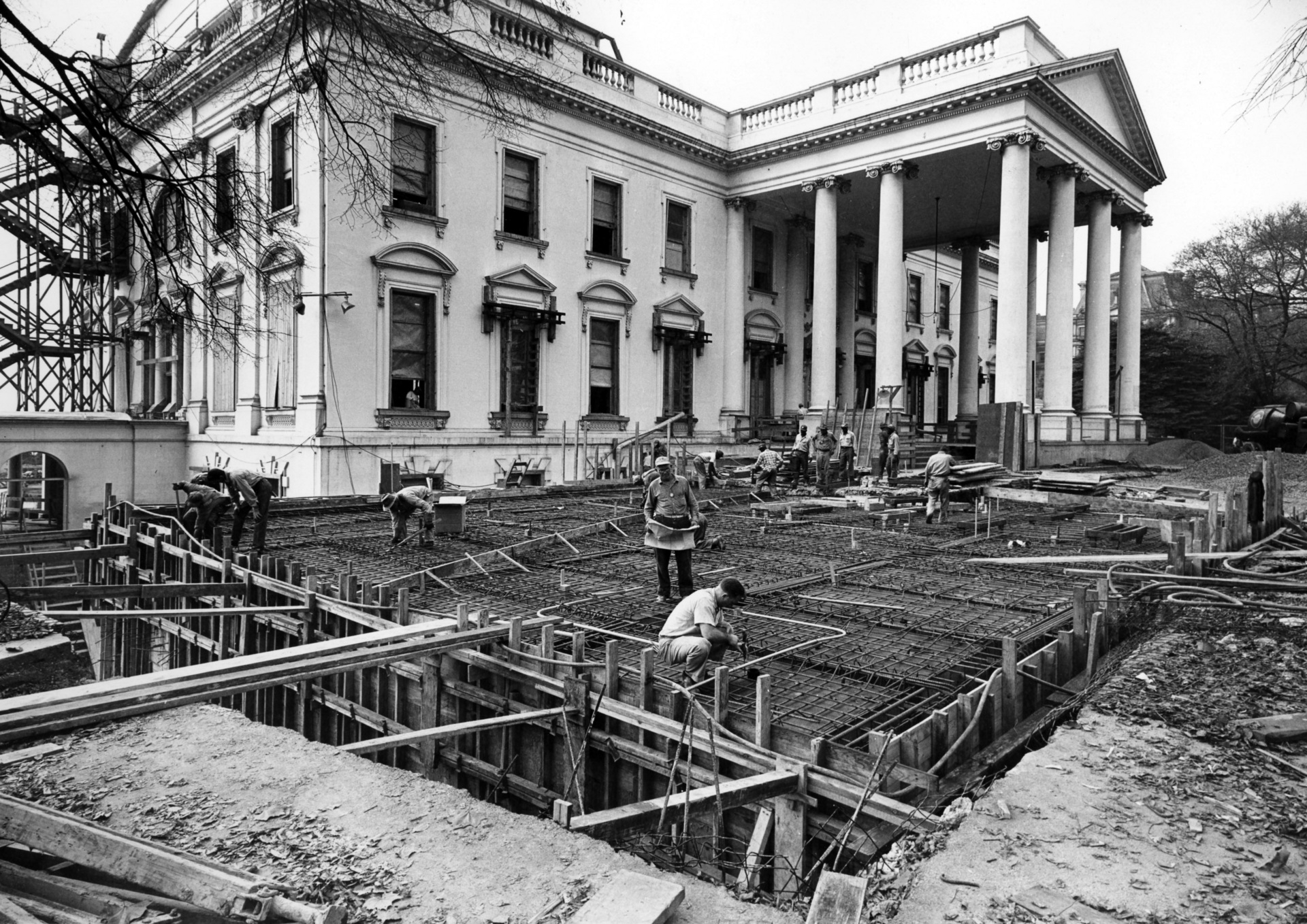
View of the northeast corner of the White House during Truman’s renovation on November 6, 1950. (Smith Collection/Gado/Getty Images).
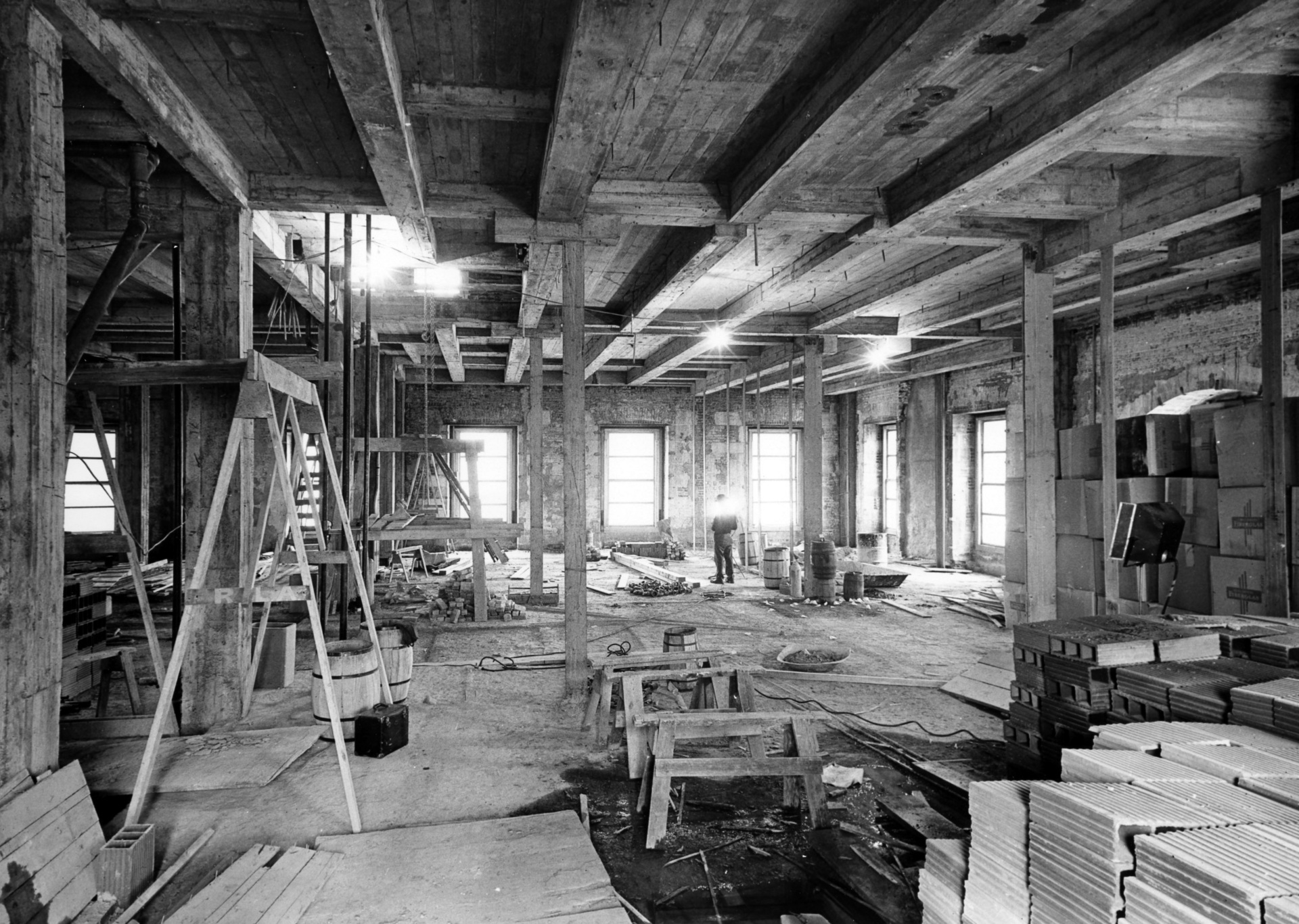
View of the Lincoln Room during Truman’s White House renovation on January 23, 1951. (Smith Collection/Gado/Getty Images).
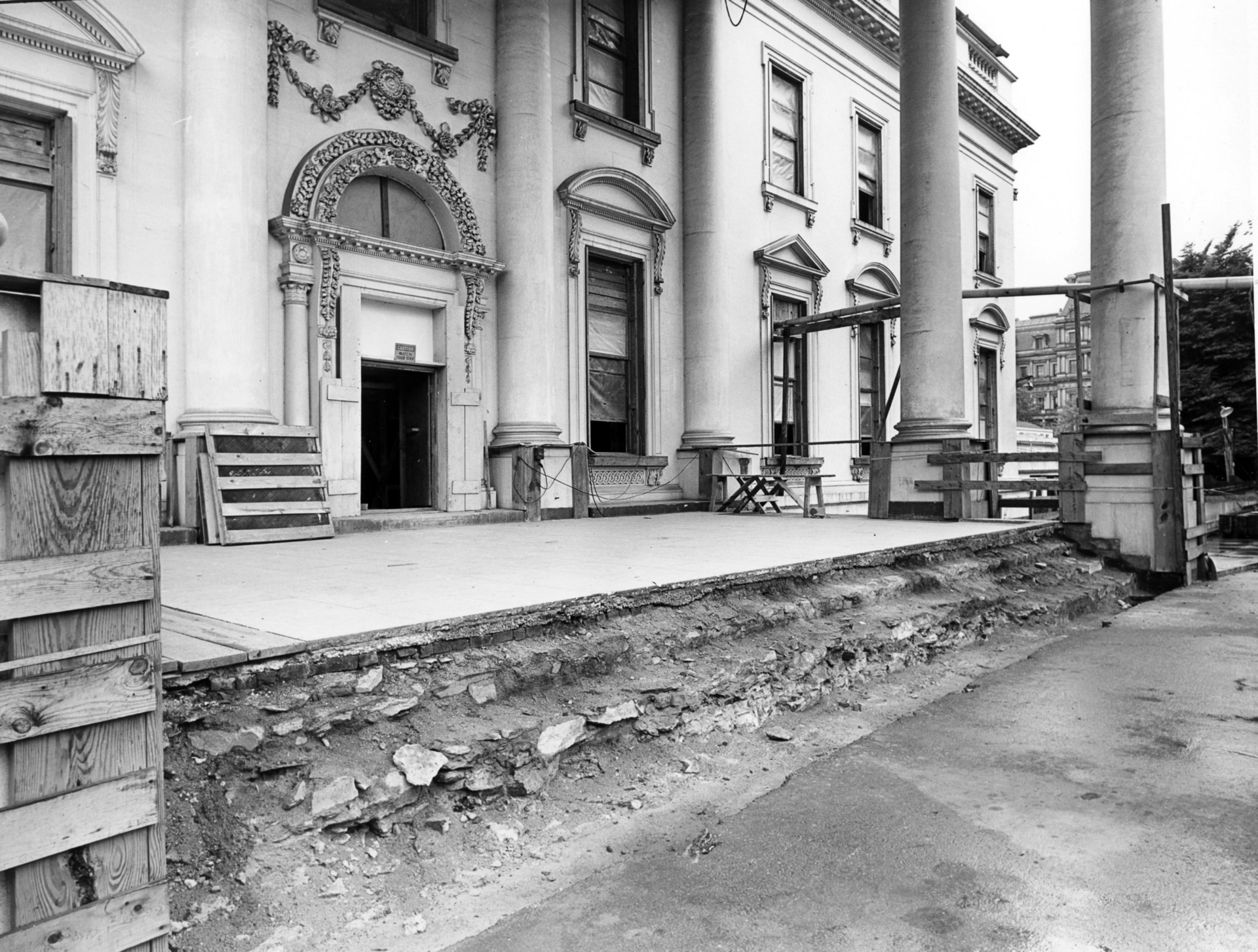
Southwest view of the north portico of the White House during Truman’s renovation on June 5, 1951. (Smith Collection/Gado/Getty Images).
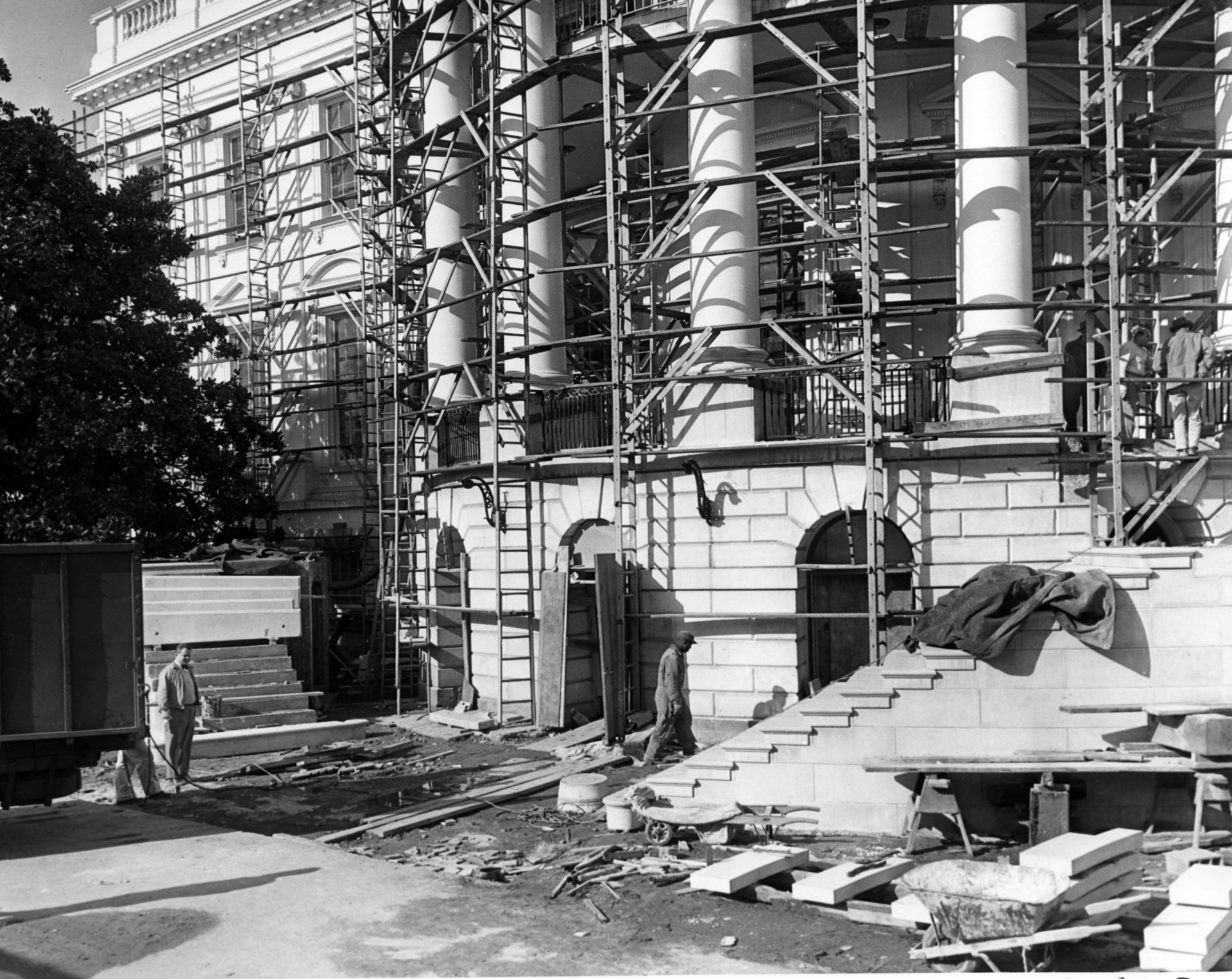
Construction of the new steps of the south portico during White House renovation on January 4, 1952. (Smith Collection/Gado/Getty Images).
In the end, even the exterior changed. Truman’s most controversial addition was the balcony on the second floor of the South Portico that is now named after him. Architectural purists criticized him for destroying the Palladian elegance of the original structure, but the Truman balcony is now as universally beloved as Jefferson’s colonnades.
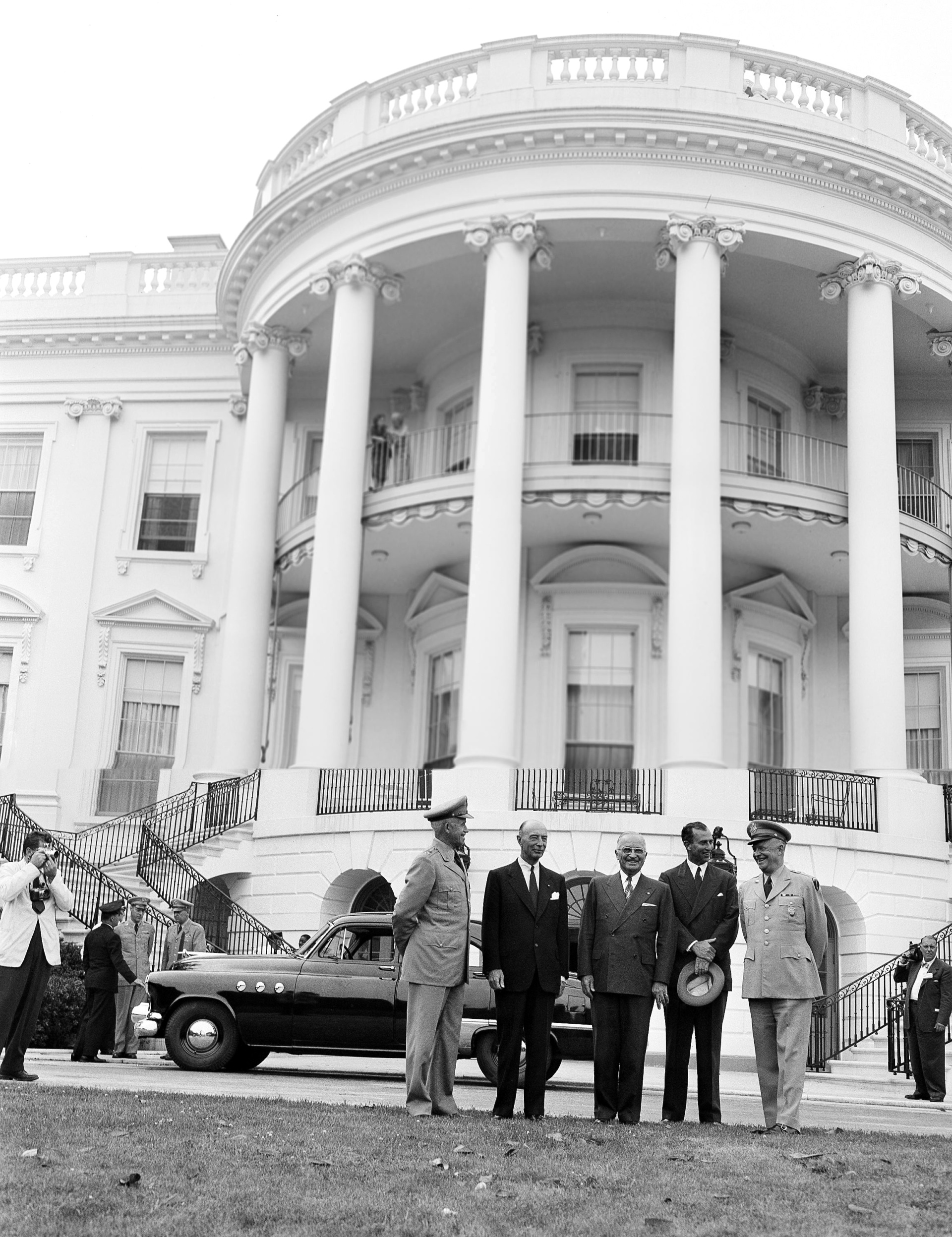
President Harry S. Truman greets his generals on south lawn of the newly completed White House on June 1, 1952, as First Lady Bess Truman and daughter Margaret hang over the railing of the new Truman balcony. Left to right: Gen. Omar Bradley; Secretary of Defense Robert Lovett; President Harry S. Truman; Secretary of the Army Frank Pace; and Gen. Dwight D. Eisenhower. (AP Photo/Charles Gorry)
The Trumans lived at Blair House until the White House rebuilding was competed in 1952.
This is the building that stands today.
This means that the White House you see today — the one the media is crowing over as if it were sacred and untouched for 225 years — is younger than Nancy Pelosi and Chuck Schumer.
Golf Cleats, Swimming Pools, Tape Recorders, and Solar Panels
President Dwight D. Eisenhower continued to modernize the White House, making it accessible for television broadcasts. He also added a putting green on the South Lawn.
Ike was as avid a golfer as Donald Trump. But unlike Trump, he liked to wear his cleats inside his office—so much so that the Oval Office floor was full of spike marks, much to the horror of Jaqueline Kennedy when JFK took charge of the White House.
First Lady Jacqueline Kennedy, perhaps more than any other American, is most responsible for the historical preservation of the White House.
She was the first of its residents since Dolley Madison to take proactive steps to protect the history and heritage of the building and its artifacts. She founded the White House Historical Association and spearheaded efforts to buy back lost White House furnishings from past administrations—because, as you’ve probably noticed, up until then the White House was treated like a glorified Airbnb, rather than a museum of American heritage accessible to the People who own it. She changed that by inviting the American people to see the inside of their House for the first time via a television broadcast.
She endured vociferous attacks from critics claiming that she was wasting money, despite the fact that her restoration work was funded by private donors. The critics were wrong yet again. Today, every administration follows Jacqueline Kennedy’s lead in fundraising to preserve the White House’s history and heritage.
Her most iconic change to the White House grounds was her renovation of the Rose Garden in 1961, which she passed through for the last time as First Lady shortly after her husband’s funeral.
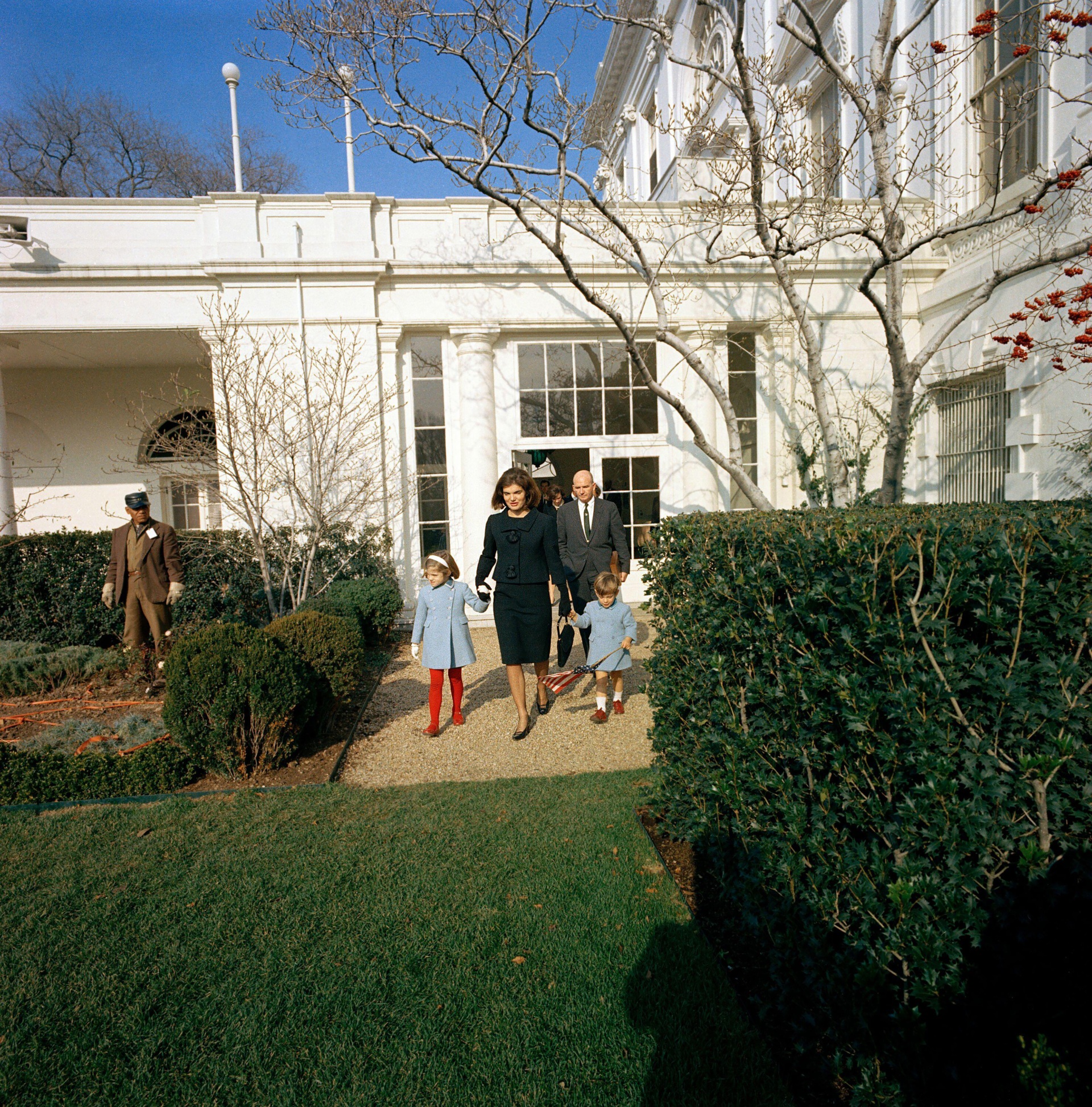
Former First Lady Jacqueline Kennedy and her children, Caroline Kennedy and John F. Kennedy, Jr., depart the White House through the Rose Garden for the last time on December 6, 1963. (GHI/Universal History Archive/Universal Images Group via Getty Images)
LBJ and Nixon famously wired the Oval Office with recording equipment… and forgot to destroy the tapes.
Nixon installed a one-lane bowling alley in the White House, and he also turned FDR and JFK’s indoor swimming pool into the current White House Press Briefing Room (so it’s still used for whoring and debauchery in a manner of speaking).
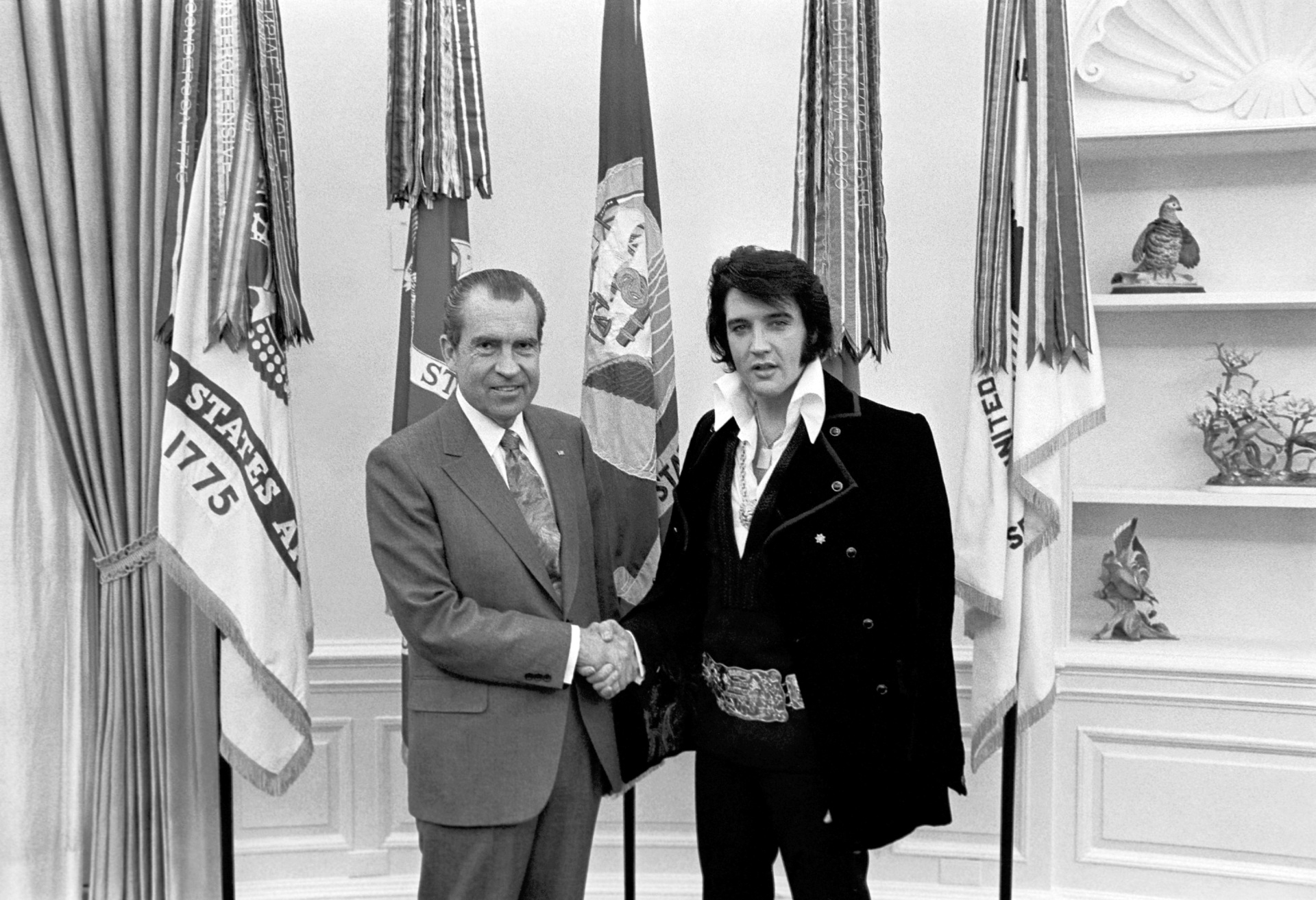
Nixon didn’t destroy the tapes, but he did shake hands with Elvis in the Oval Office on December 21, 1970, as seen in this iconic photo of “The President and the King.” (Pictures From History/Universal Images Group via Getty Images)
Gerald Ford was sad to see the indoor pool go, so he added an outdoor pool that is still there today. While digging up the yard to install it, workers discovered artifacts dating back to the 1814 fire.
Needless to say, with inflation running rampant during his hapless presidency, Ford didn’t do himself any political favors by building a fancy swimming pool for his own amusement. Unsurprisingly, Mr. “Whip Inflation Now” got whipped by Jimmy Carter, the peanut farmer from Plains, Georgia, whose interest in water sports was limited to fishing and killer swamp rabbits.
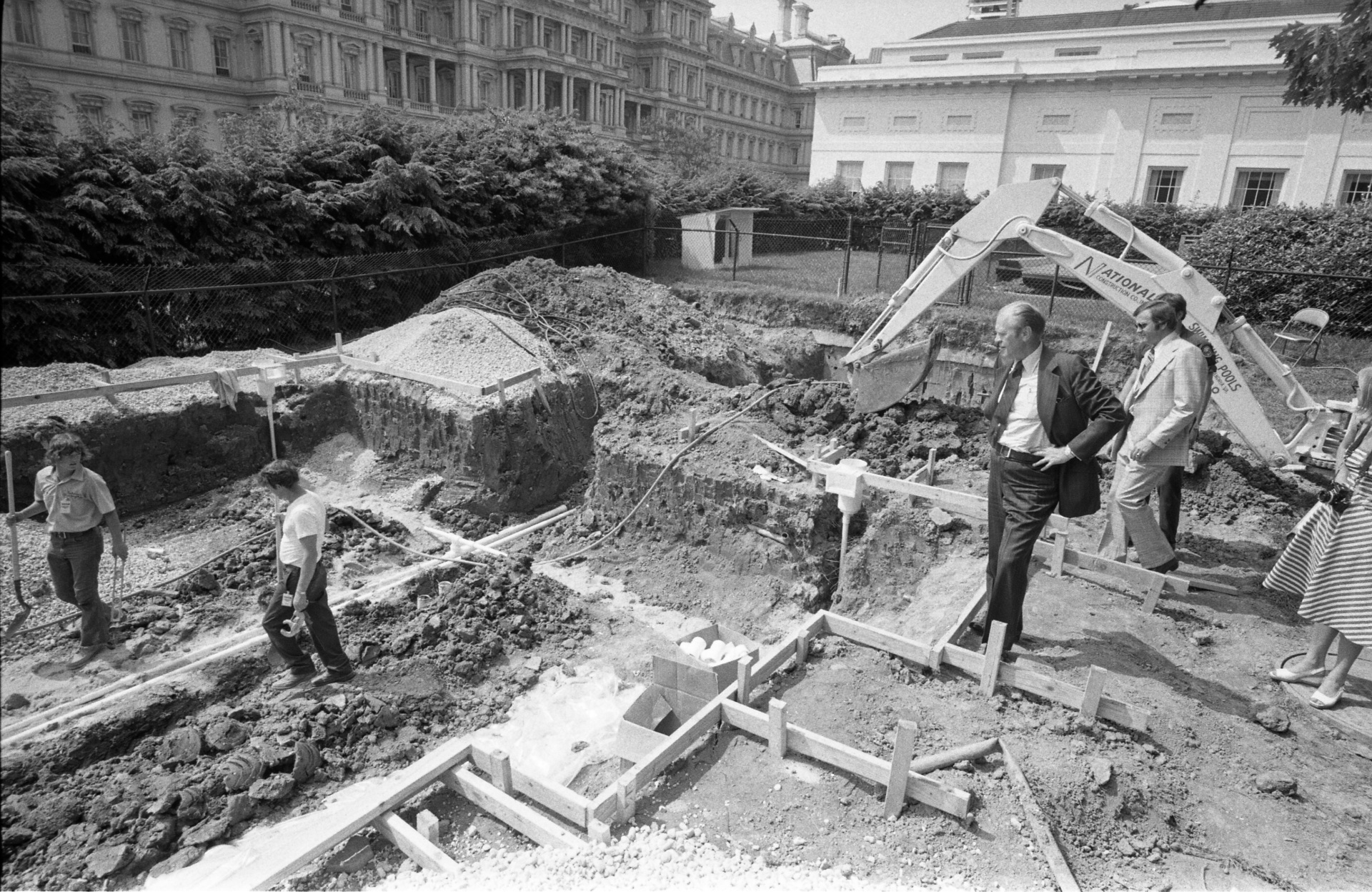
President Gerald Ford inspects the construction site for his White House swimming pool on May 20, 1975. (U.S. National Archives and Records Administration)
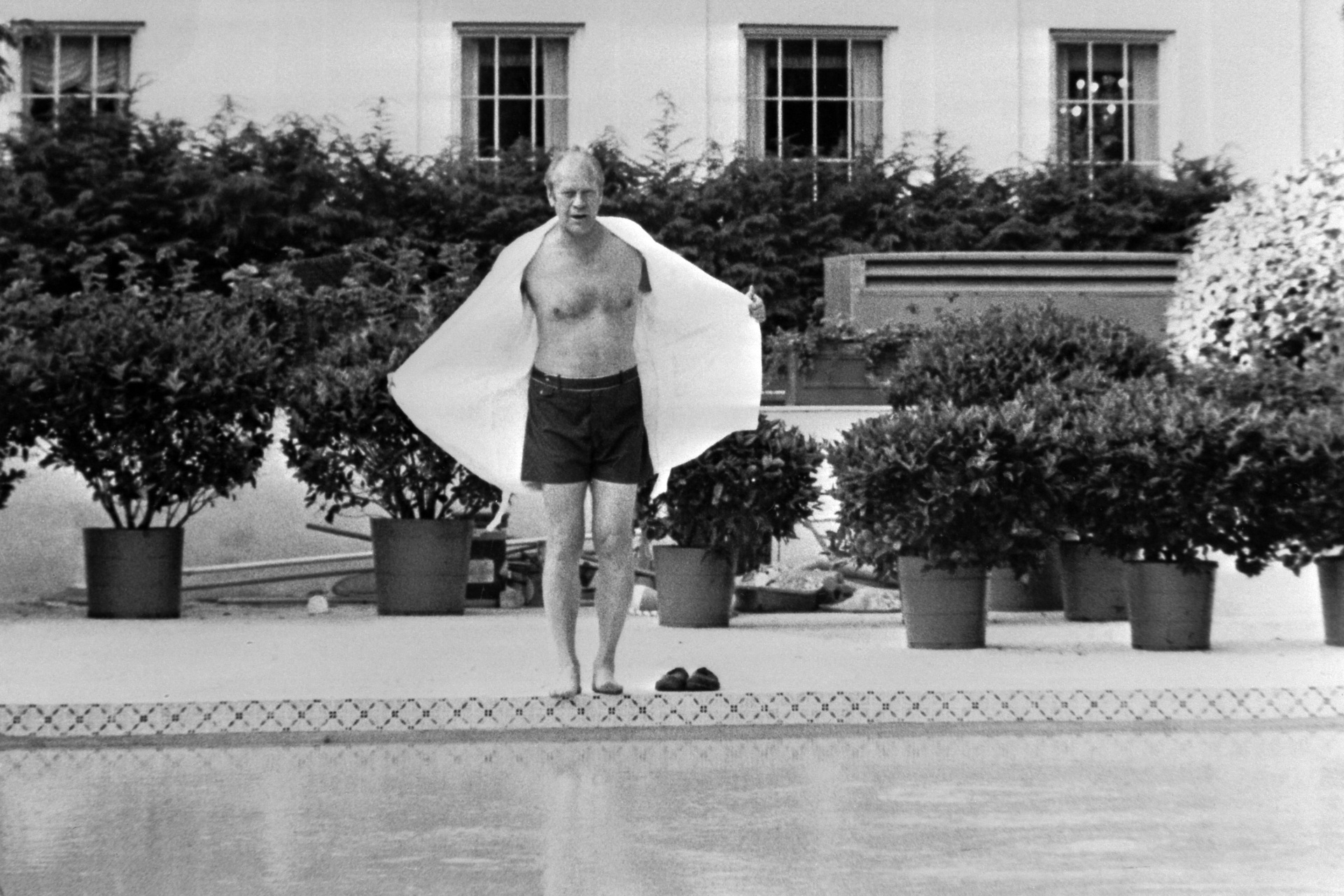
President Gerald Ford preparing to take a swim in his new outdoor swimming pool at the White House, on July 10, 1975. (STR/AFP via Getty Images)
Jimmy Carter installed solar panels at the White House… because of course.
Ronald Reagan promptly removed them… because of course.
Barrack Obama installed them again… because of course.
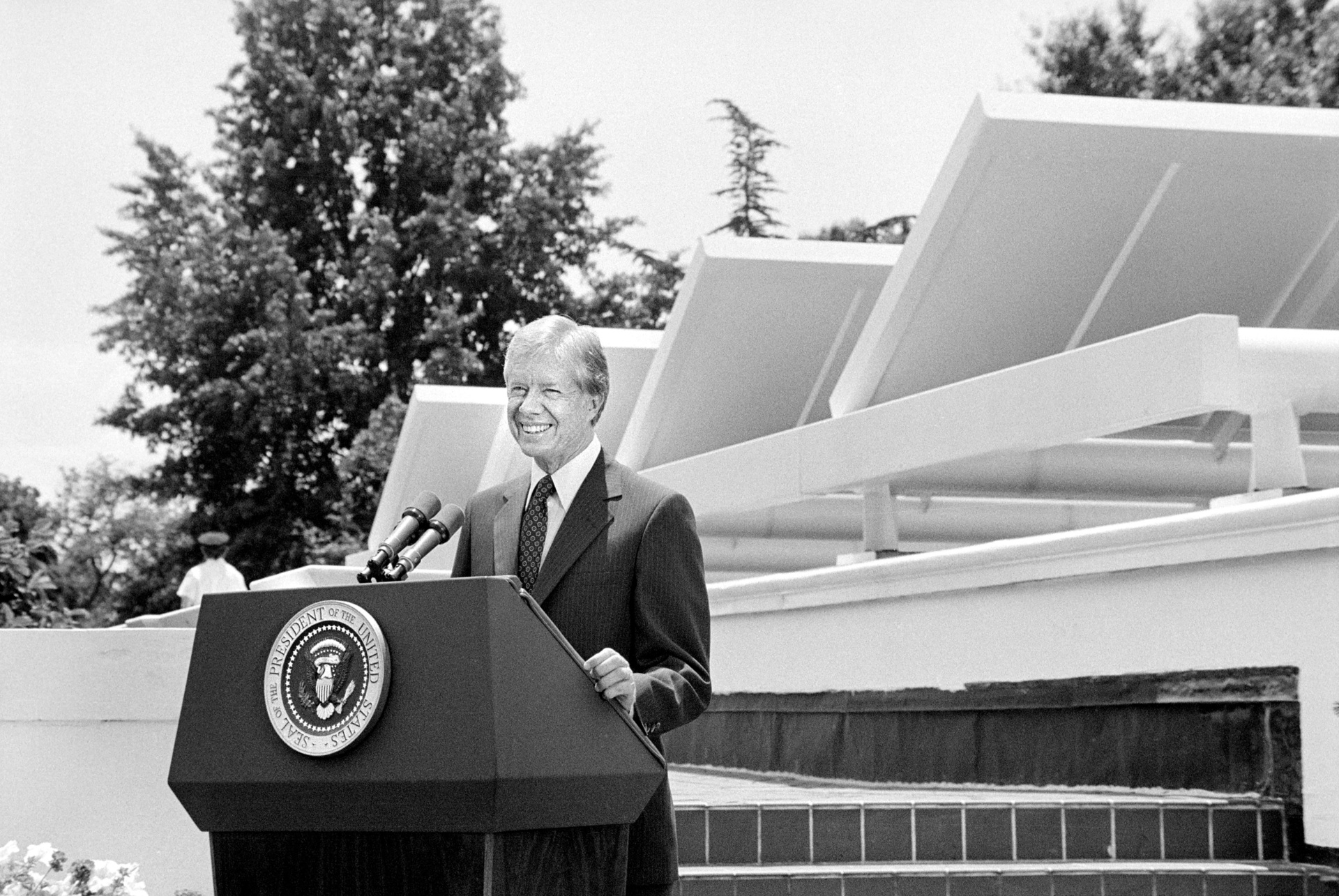
President Jimmy Carter speaking in front of solar panels placed on West Wing Roof of the White House, announces his solar energy policy, on June 20, 1979. (Universal History Archive/Universal Images Group via Getty Images)
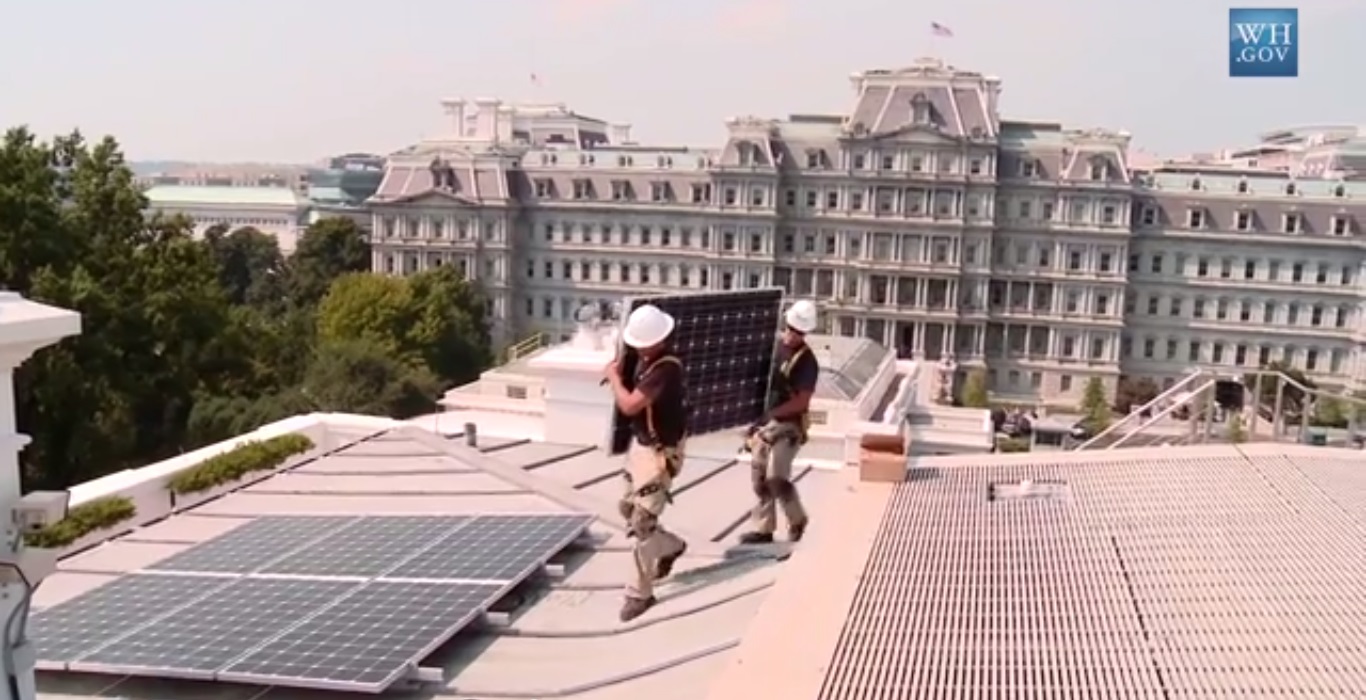
Workers install photovoltaic solar panels on the roof of the White House during the Obama administration in May 2014. (Obama White House video)
Bubba and Hillary’s Love Shack and B&B
George Bush Sr., who signed the Americans with Disabilities Act (ADA) into law in 1990, made the White House ADA-compliant. George Bush Jr. was too busy blowing up the Middle East to spend time on building projects, but he did renovated the White House Situation Room and the Press Briefing Room.
Of recent memory, the president who really had a stand-out impact on the integrity of the White House was Bill and Hill—that’s right, two for the price of one!
As we all know, Bill Clinton got serviced by his intern — not in the pool room or the closet, but in the Oval Office.
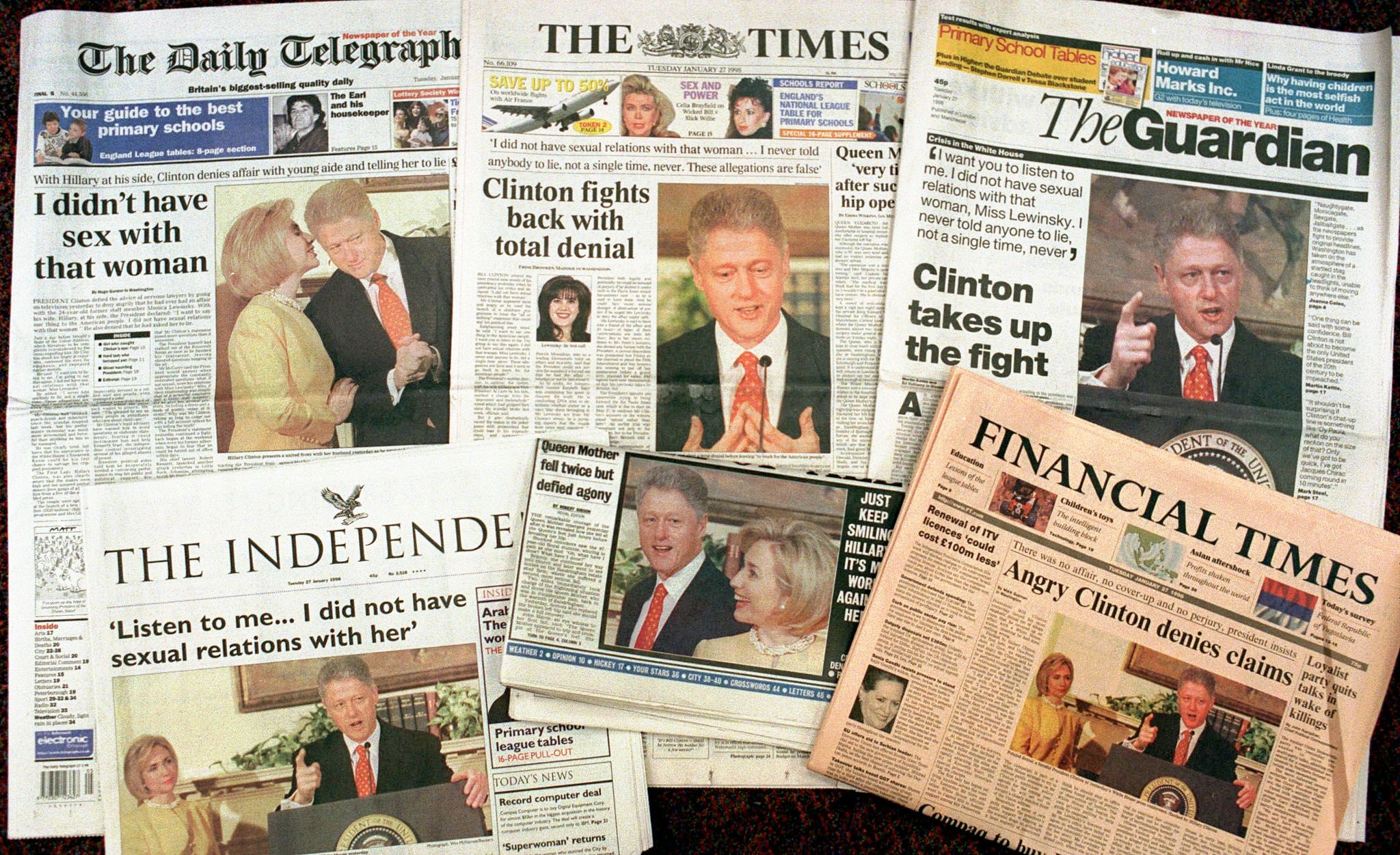
A montage of British daily newspapers published on Jan. 27, 1998, headlining President Clinton’s denial that he has had sex with Monica Lewinsky, which was definitively proven when his DNA was found on Lewinsky’s dress. (AP Photo/Martin Cleaver)
But that’s not all that Bubba did. He and Hillary also auctioned off sleepovers in the Lincoln Bedroom as a fundraising gimmick.
The room that we now refer to as the Lincoln Bedroom was not actually Honest Abe’s bedroom. It was the approximate location of the room that Lincoln used as an office. We also don’t know if he actually slept in the bed there, which was purchased by Mary Todd Lincoln for a guest bedroom.
The Lincoln Bedroom mainly functions as the place where the White House displays Lincoln’s things (i.e., his desk and chairs, a copy of the Gettysburg Address and the Emancipation Proclamation). For that reason alone, the room is regarded as a national treasure. And that’s why the nation found it so disturbing to see two of Bill and Hillary’s friends, Markie Post and Linda Bloodworth-Thomason, jumping up and down on Mary Todd Lincoln’s antique bed.
Fast forward to today. The Clintons–Bill, Hill, and even Chelsea–are accusing Trump of defiling the “People’s House” by building a ballroom for the People. Hillary is so upset that Trump is “destroying” the White House that she’s selling t-shirts to remind people that the White House is “not his house” but “our house.”
This makes sense because she definitely felt that it belonged to her when she was selling White House sleepovers to the highest bidder.
She also felt very proprietary about “our house” when she and Bill carted off furnishings and china donated to the White House on their way out the door. They were later forced to return them due to the public outrage this sparked.
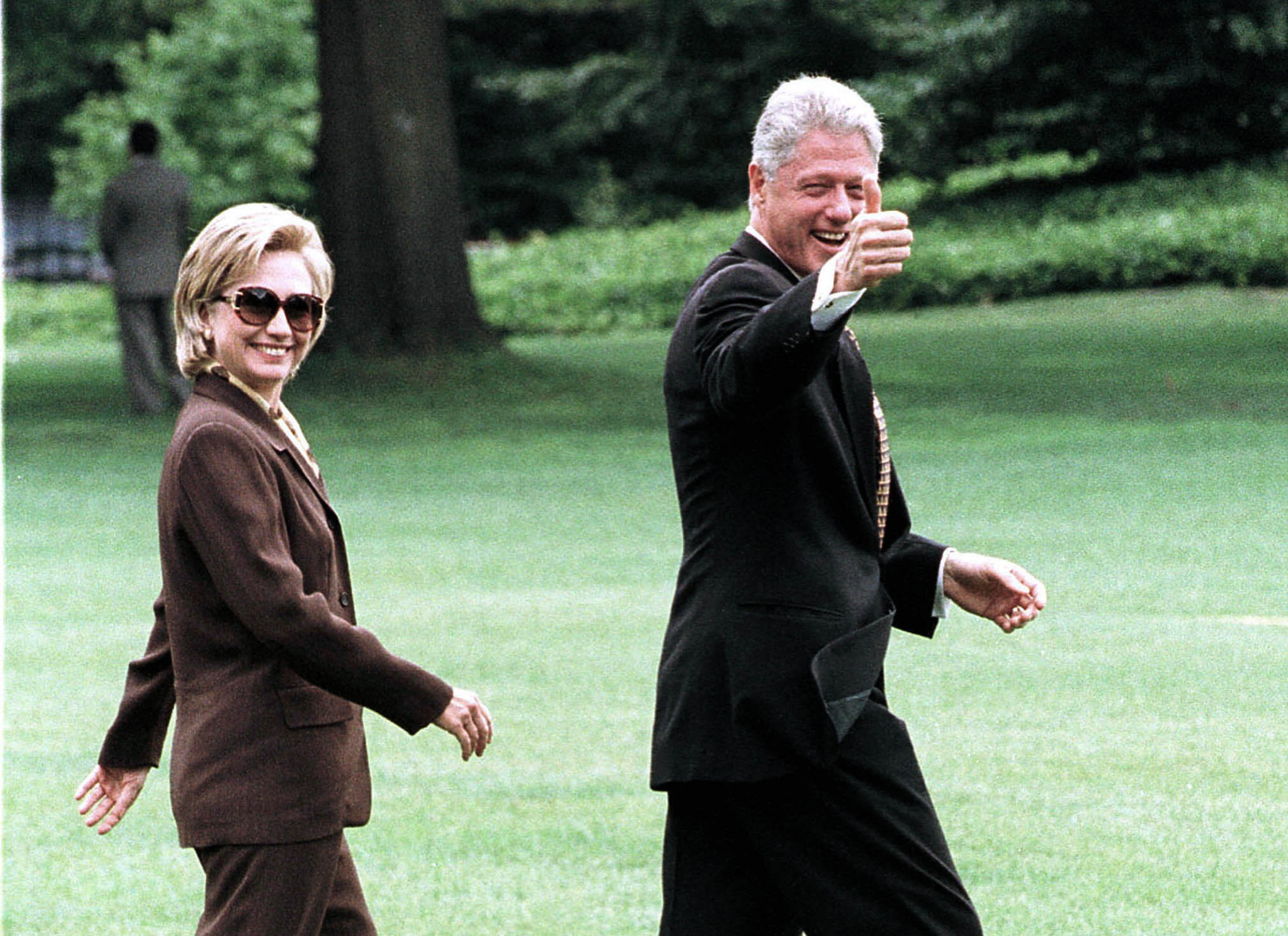
President Bill Clinton gives a thumbs up sign as he and First Lady Hillary Rodham Clinton walk to Marine One to depart for a weekend trip to the Hamptons on July 31, 1998. (Karin Cooper/Getty Images)
Topless Trannies and Coke
No summary of White House degradations would be complete without mentioning the time Joe Biden hosted a transgender saturnalia on the South Lawn that devolved into a tranny strip tease.
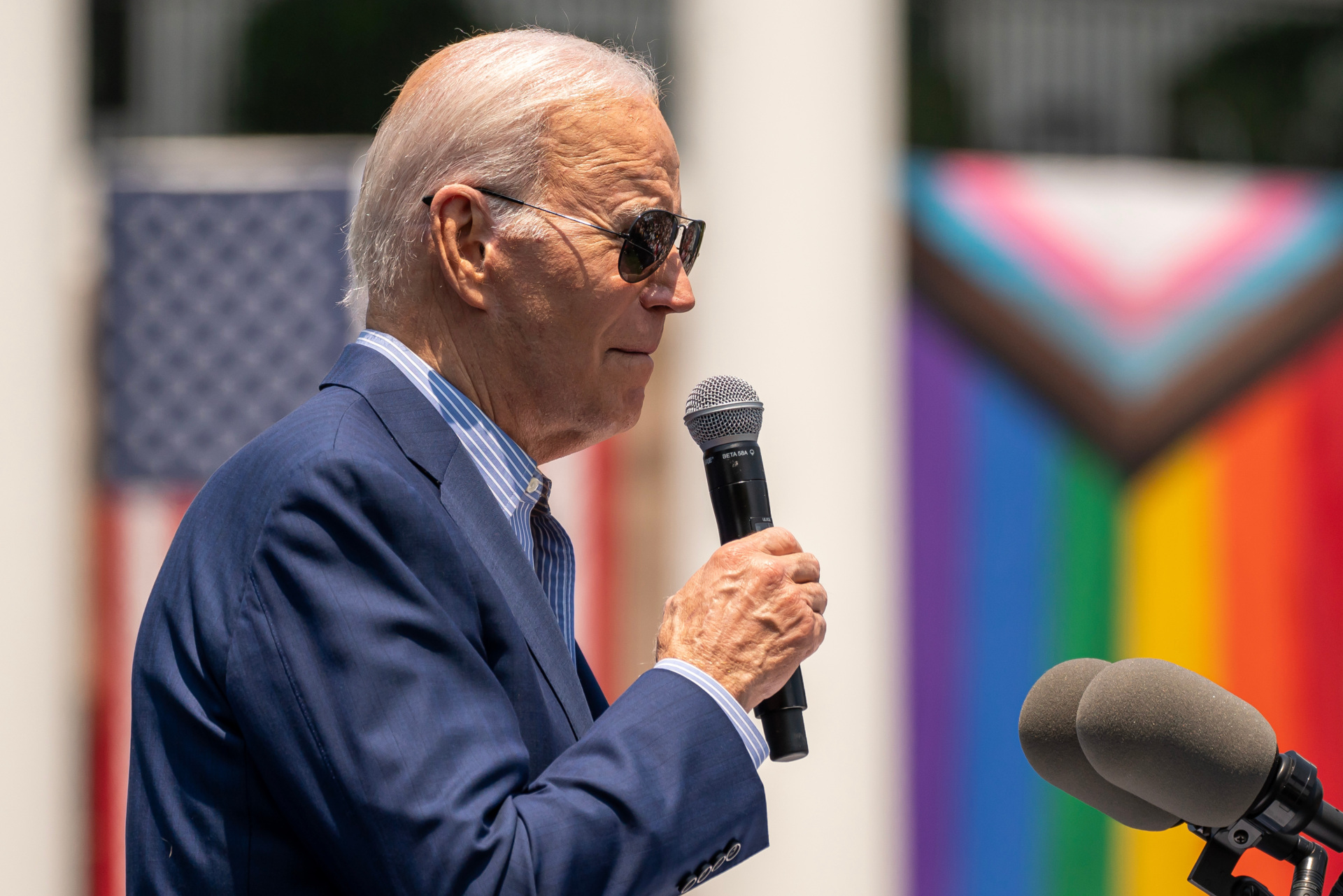
President Joe Biden speaks during a Pride Month celebration event at the White House on June 10, 2023. (Nathan Howard/Bloomberg via Getty Images)
Everyone liked to party hard in Hunter’s dad’s White House.
Speaking of Hunter, there was also that time when the Secret Service found a baggie of cocaine in the West Wing during a weekend when he was visiting.
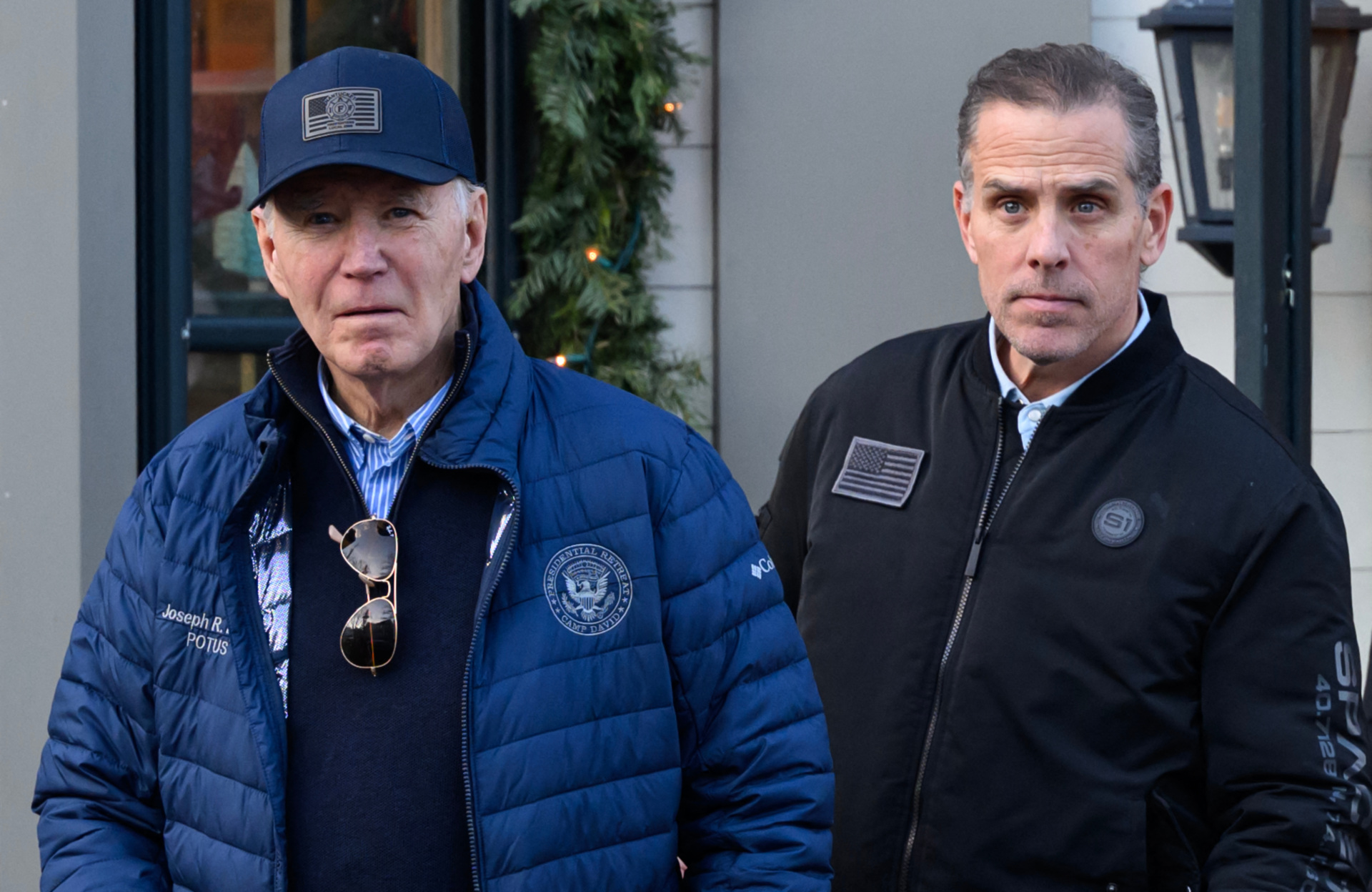
President Joe Biden and his son Hunter Biden on November 29, 2024, in Nantucket, Massachusetts, shortly after Biden issued an official pardon for Hunter. (MANDEL NGAN/AFP via Getty Images)
Trump’s Big Beautiful Ballroom
By now, we can see four patterns in White House renovation history:
- Every White House renovation is met with criticism–often for political reasons. But with time, most of the changes are embraced, and no one even remembers the criticism.
- The White House is not a mausoleum frozen in time. It’s constantly changing.
- The projects are always criticized for wasting money, even though many of them rely on private donations.
- The most lasting renovations are the ones that serve the American people, not just the presidents.
For all of these reasons, Trump’s Big Beautiful Ballroom is in keeping with the best traditions of his predecessors.
First, his critics are almost all politically motivated, and their criticism is unlikely to stand the test of time. Do they really want us to believe that the man who respectfully restored the Plaza Hotel and Mar-a-Lago will be careless with the White House? You might think he’s winging it when it comes to Middle East peace, but you cannot seriously claim that he doesn’t know how to build a ballroom.
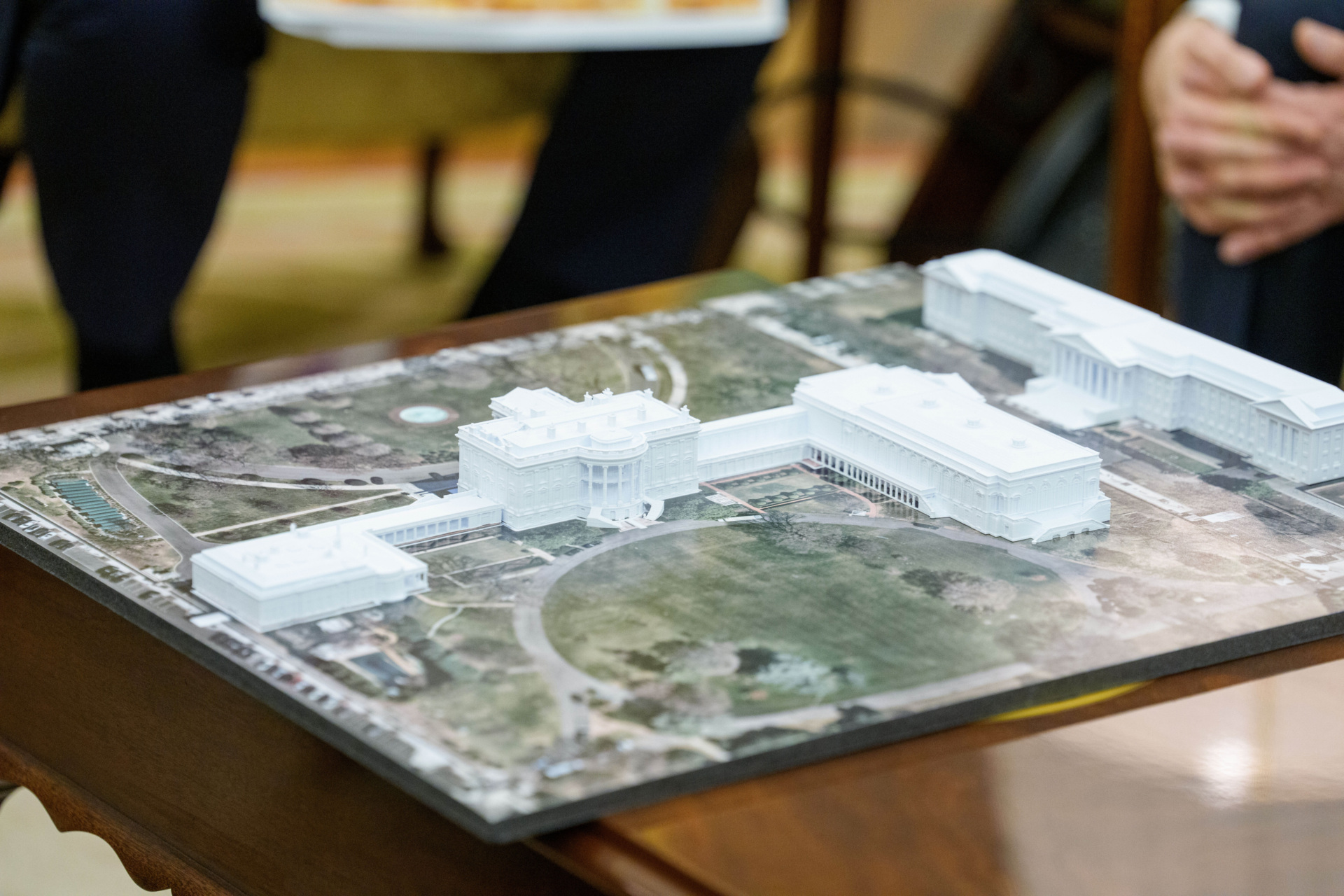
President Donald Trump displays a model of the planned ballroom extension on Oct. 22, 2025, in the Oval Office. (Aaron Schwartz/CNP/Bloomberg via Getty Images)
Second, his design is objectively beautiful and will replace an East Wing that is nowhere near as stunning as this. Yes, it does have a Versailles-like quality to it. But Trump likes Versailles. He wants his “Golden Age” to have a Gilded Age patina. Perhaps, as a New Yorker, he’s nostalgic for Mrs. Astor and her Four Hundred. It’s also true that he loves beautiful buildings and dislikes the brutalist architecture that has made our cities ugly. This ballroom is one more way that Trump is advancing the cause of beauty.
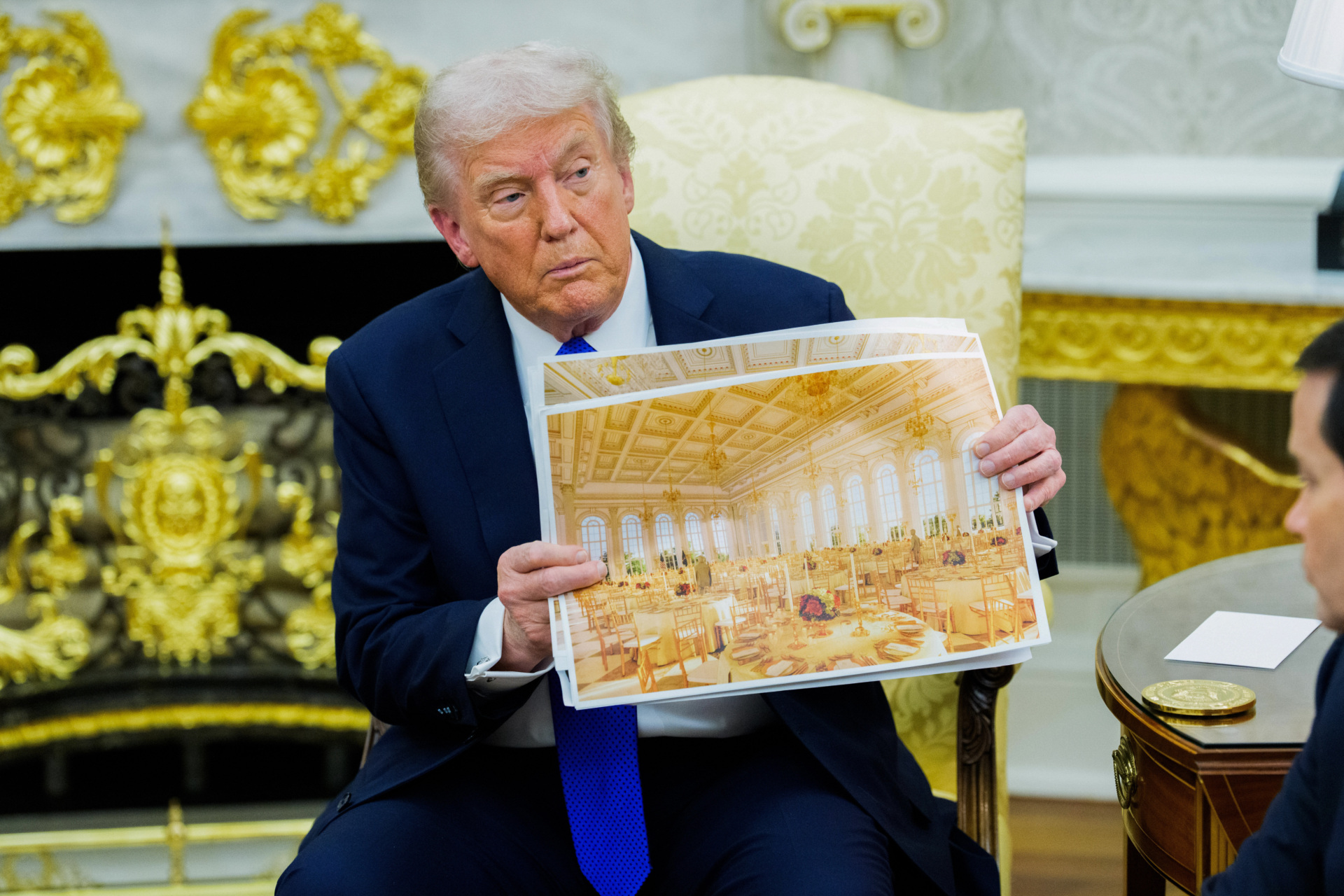
President Donald Trump holds a rendering of the planned White House Ballroom extension on Oct. 22, 2025. (Aaron Schwartz/CNP/Bloomberg via Getty Images)
Third, the taxpayers aren’t footing the bill for this, private donors are–the same way private donors paid for FDR’s swimming pool and Jackie Kennedy’s White House furniture purchases.
Fourth, this ballroom is for the benefit of the nation, not Donald Trump. By definition, a ballroom is a communal structure. Unlike the presidents who added pools or game rooms to the White House for their own amusement, Trump is building something beautiful for posterity. The real question is why haven’t more of our presidents in recent years done this? Why did we stop building big beautiful things?
The Wall Street Journal reports that Trump reached out to President Obama in 2010 with an offer to build the White House a ballroom because our country lacks a truly elegant venue to host state dinners:
“[Trump] said, ‘You have these state dinners in sh—y little tents,” [former Obama aide David] Axelrod recalled in an interview. “He said, ‘I build ballrooms. I build the most beautiful ballrooms in the world. You can come to Florida and see for yourself.’ ”
Trump offered to build a modular ballroom at the White House that could be deconstructed. “I was thinking, we’re in the middle of a recession, I’m not sure about this,” Axelrod said. Axelrod suggested that Trump get in touch with Obama’s social secretary about the ballroom. They didn’t connect.
This was shortsighted of Obama. Yes, the country was in the middle of the Great Recession in 2010, but we were in the middle of a financial panic when Teddy Roosevelt built the East and West Wings; we were in a Great Depression when Hoover repaired the West Wing; we were in a World War when FDR rebuilt the East Wing; and our whole capital was burned to the ground by foreign invaders when Madison and Monroe rebuilt the White House from scratch.
There has never been a perfect time to build anything in D.C., but we do it to show that we are advancing as a country, not retreating.
Like Jefferson’s colonnades and Truman’s balcony, Trump’s ballroom will add to the aesthetic heritage of the White House and expand its visual history for generations of Americans.
We should be celebrating this. We should let this man cook. Building is what he does — and particularly historical renovations. He’s the most qualified president to oversee a White House building project since Jefferson. And his desire to build America a ballroom is a reminder that our White House isn’t a mausoleum, and our country isn’t dead. The only colossal structures that remain frozen in time are colossal ruins.
As for critics who claim that the current East Wing must be left untouched, do they realize that it was built to conceal an underground bunker? There is nothing sacred about it. It’s mostly office space. A great and self-respecting nation doesn’t hold state dinners “in sh–y little tents” just because we refuse to remodel a building that’s younger than Joe Biden.
So, let Trump build us a big beautiful ballroom. And, yes, it is for our benefit. Beauty is necessary for a country and a civilization. And many people reading this article will someday dance in that beautiful ballroom, and many millions more will visit it during a White House tour.
One final word of warning for the president: Nothing is permanent in the White House except the sandstones. Build your ballroom in stone.
Rebecca Mansour is Senior Editor-at-Large for Breitbart News. Follow her on X at @RAMansour.

